#its just a lot harder to organize and layout compared to part 1 which was just an explanation
Text
Boy King Seb :D

#thank you to Grace for the idea of making his chivarly collar red bull instead <33333#he was gonna have both collars but then making that one made me suffer so no not today#this was a lot of fun but also made me suffer. but i keep looking at it and being like AAAHHHHH BABY!!! BABY BOY!!!!!!!#can you believe i tried to do this in one night? i cant#i stopped and came back to it and was like 'no way you could do this in one sitting at 1 am'#this is kinda the ascended form of that very first sketch i made for this au! concentrated boy king sebby!!!#i say to myself i need to take a break from drawing complicated things but youll prob see a nando version of this in less than a week ;;;#okay about the drawing(i wrote good tags and then tumblr deleted them so these are a bit inferior AGH):#this is typical pouty seb but is also referenced off a specific pic from AD 2009(beloved)#its very important to me how emotionally open Seb is. im not sure the specific context of this. maybe after a triumph?#but instead of being that typical stoic serious detached kind of ruler; i like him being openly emotional(think AD 2010)#its important as well for his dichotomy with nando and how they choose to portray themselves#seb is very assured in himself and his rule vs. nando who is more insecure and bitter about his#so nando takes strides to portray himself in that more stoic calculating way bcs he feels like it helps him legitimize himself better#whereas seb has absolutely no care for outward public image and shows how he feels and is loved for it(nando hates it but loves it)#not that nando cant be fun and whimsical!! but to me he always seems a bit more mysterious; like i can never tell his true thoughts tbh#anyways i feel like ill finish 10 more drawings before i end up posting the lore pt 2 LMAO#its just a lot harder to organize and layout compared to part 1 which was just an explanation#pt2 would be a mix of more world building/characterization/anecdotes ive talked about with mutuals(LOVE YOU GUYS!!!)#i have a *lot* of ideas (gotta whip out my notes app every once in a while to write down stuff abt it) just hard to put into a coherent pos#sebastian vettel#f1#formula 1#f1 art#formula 1 art#f1 fanart#formula 1 fanart#catie.art.#*ill prob make a process post later if anyone is curious!! its fun to write abt my process and influences and such#boy king au
39 notes
·
View notes
Text
Why Produce A Roku Channel For Growth Marketing

Roku revealed its Q4 revenues results last Thursday, which emphasized its setting as a very early leader in the connected TV market thanks to solid holiday equipment sales together with higher advertisement sales.
The business remained to expand its individual base, with global active accounts getting to 36.9 million, a 36% year-over-year (YoY) uptick. While that's still less than Amazon Fire TELEVISION's 40 million energetic customers, Roku much surpasses its opponent in regards to time spent: Roku recorded around 43% of worldwide connected-TV viewing time in Q4 2019 compared with 18% for Fire TV, according to recent Conviva research. In outright terms, Roku reported an approximated 11.7 billion complete streaming hours in Q4 2019, a 60% YoY boost.
Roku has had success monetizing its expanding involvement-- its ad organisation is on the increase after the firm increased advertisement capabilities and also presented brand-new layouts in 2019. Roku's typical profits per customer (ARPU) increased 26% YoY, in Q4 2019 to $23.19 as well as system earnings increased 71% YoY in Q4 to $259 million. The company likewise offered far more impacts in 2019 than in the year prior: Roku said its monetized video advertisement impressions greater than doubled over the course of the year.
Roku's growing ad organisation was driven by a few consider 2019, including its acquisition of dataxu, the advertisement tech firm which has allowed advertisers to get Roku positionings through third-party publishers carried on the platform. One more major vehicle driver is the popularity of Roku Channel, the firm's very own free, ad-supported channel that now organizes over 55 online linear channels, children material, as well as personalized web content selections. According to the revenues launch, the Roku Channel now gets to an estimated 55 million customers.
Right here's just how Roku could attempt as well as develop its advertisement company even further across 2020 as OTT advertising expands extra common:
- Increasing Roku Channel web content. This year will certainly see the launch and development of both subscription streaming solutions like HBO Max, Apple TELEVISION, and Disney+ and ad-supported services like NBCU's Peacock. To proceed growing Roku Channel's viewership-- and, as necessary, preserving advertiser passion-- the business will likely require to get new content that distinguishes the channel from other alternatives.
- Scaling global reach. Despite its users being concentrated in the USA, Roku has seen early success in the UK and Brazilian markets, both of which it entered in 2019. Although it likely faces harder competition abroad-- particularly from Samsung, which regulates 21% of the worldwide Smart TV market, per Strategy Analytics-- there is plainly space for growth in choose countries.
As Roku builds out its ad organisation more strongly, it's particular to encounter challenges-- as well as one such point of friction could be author arrangements. On the weekend of the Super Bowl, Roku almost failed to reach an agreement with Fox over the legal rights it includes its application Fox Sports and its pay-TV confirmed application Fox Now.
The disagreement occurred in part over Roku's expectation that an application share 30% of profits from their supply for being included on their gadget-- a sticking point for programmers like Fox, whose advertisement inventory was most likely particularly valuable that weekend.
As more authors push their OTT applications to Roku gadgets and also Roku begins to additionally focus on ad revenue, carriage conflicts like this could come to be extra common. And also, as with linear carriage conflicts, the worst case situation is that the channel concerned is dropped from the system completely.
Television Marketing:
This is my preferred advertising tool. Numerous things have actually changed in this field. The cost to reach a lot of people is a lot less than various other forms of advertising and marketing. Also, you have a captive target market.
Unlike a mail item that they can toss in the trash, or a publication or paper that they can toss to the side, your target market is kicked back, as well as receptive to seeing short visual advertisements.
Yes, traditional TV can be out of reach to most business, however the most up to date pattern is Streaming TV Media, which is within reach of many budget plans. Audiences acquire a "Smart TV" set-top box such as Roku, Apple TELEVISION or Amazon.com Fire among others to connect to their TELEVISION, and they have access to a large platform of streaming channels including TELEVISION programs, Movies, Sports and more. A good example is ADEYS.tv, around the world their target market gets to upwards of 250,000 customers a month. This is because they use special material only readable on their network, as well as an exceptional means to construct a devoted audience. There are just 1-2 ads shown throughout a commercial break, as well as viewers can't avoid over them like on mainstream cable TV.
Deciding what marketing tool is best for you, or what mix thereof, is solely based upon budget and also need of your individual service. Take your time, do your research and also explore choices. Do you need targeted advertising and marketing or would certainly you benefit a lot more from a broad audience? Possibly, like a lot of us, you require both which is why from the time you took Advertising and marketing 101, we were constantly shown the "advertising and marketing mix". Whatever you make a decision, be sure you do something, because in today's competitive market, you're either expanding or fading away.
how to start your own tv show
youtube
1 note
·
View note
Link
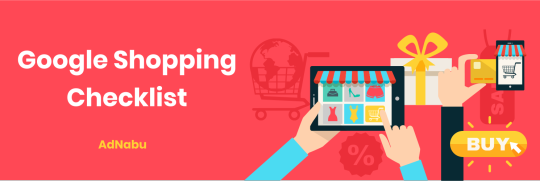
Google Shopping Campaigns help you advertise and sell your products via Google platforms using their prerequisite formats.
Google Shopping allows enables users to search and compare products directly on a Google platform, depending on their search queries. After you submit your product in the format given by Google, it shows up as a product ad; this small square of online real estate that’s extremely viable to sell products.
Google Ads and its partner tools have stormed the world of eCommerce and retail, not least because they facilitate focus on more crucial parts of running a business and automate frustrating processes that once consumed a lot of time and effort.
What is a Google Shopping ad?
Google Shopping advertisements are based on search terms images, not keywords like standard text ads. This makes them more engaging and convincing, and your website or online store is likely to boost leads and conversions.
Google Shopping ads fall under the category of paid ads and are also generally known as Product Listing Ads, a term that Google once used. They appear across Google’s Search and Shopping platforms and are open for users to view and click on, should they be interested. They’re a crucial advertising channel for eCommerce businesses because appearing in search network results early in the search funnel allows retailers to drive direct conversions and be noticed from the beginning of a buyer’s journey.
A sophisticated Google Shopping plan is a must for marketers and e-retailers looking to make a big splash this year and in future years, because comparison shopping is trending in the consumer world and this tool makes it all the more accessible.
Why do you need Google Shopping Ads for your eCommerce business?
Despite its many benefits, Google Shopping Ads continue to be overlooked by retail players both big and small. In fact, these ads account for only 20% of retail paid search clicks according to Forbes, so the remaining 80% makes a more than viable entryway into driving more conversions. In a nutshell, Shopping Ads generate sales for your eCommerce store. While breaking down the benefits, though, these ones stick out:
Benefit #1: More effective than text ads.
A traditional Google Shopping Ad displays a high-quality product image, a clear headline, and a price tag. Sometimes they may even contain star ratings and reviews. The added visual element instantly attracts a user’s eye, way more effectively than a chunk of text would however well be written it is.
Benefit #2: Links to your product data feeds.
Shopping ads are created with information from your data feed. The automated feature pulls data relating to product headlines and pricing from your feed on Google Merchant Center, which is why it is important that this feed is up to date, complete and accurate. However, this bypasses the process of manually creating shopping ads and adding photographs which, needless to say, is highly time-consuming.
Benefit #3: Increases conversions.
Research has found that marketers who spend more on Google Shopping Ads while looking at it as a viable advertising option tend to see up to 130% higher rates of conversion in comparison to normal shopping ads. This is in part because it’s placed overall organic and traditional PPC ads. The visual content adds to the winning formula because it’s interpreted faster and better by the human brain, unlike plain text which constitutes the rest of the search page.
Benefit #4: Can include additional information.
Google Shopping ads aren’t limited to image and headline; by using extensions, a business can include more relevant information for users. This could boost engagement and drive sales. Examples of these are reviews and special promotion indicators. By making them this customizable, Google essentially allows marketers to maximize the use of minimal ad space.
Benefit #5: Reduced Costs Per Click.
Shopping Ads inevitably lead to better click-through rates. This, in turn, lowers your costs per click, which not only saves ad spend but also gives you more traffic for what you have invested. In the long run, this leads to higher returns on investment (ROI) which means you could invest more and see higher sales.
Benefit #6: Great mobile visibility.
On mobile browsers, traditional PPC ads are only shown two at once. This makes it much harder to secure a spot because it’s valuable and highly competitive. However, Google Shopping Ads get placed by default onto the top. The carousel layout also allows up to 15 search results currently, which means competition isn’t as tight- it all boils down to how relevant your product is to that particular mobile user’s search query.
Benefit #7: Automatic updates.
This is a huge draw of using Google Shopping Ads. Once you’ve set up a product feed on Google Merchant Center, Google Shopping campaign is automatically updated every night to ensure that you’re not bidding on out-of-stock products, broken links or irrelevant search queries. It works the same way with adding products; fresh products are added to the feed within a fixed time frame so there’s no need to manually manage ads.
Benefit #8: Clearer data.
Analytics data for Google Shopping Campaigns are generated based on products, not by product type or ad group. This way you can filter and segment data dimensions based on products or product attributes. This gives you a clearer picture of ad spend and segmenting and also helps to identify what product is selling better, in case you’re looking to optimize it or promote it more. With a little more research, you can also get anonymous data about your competitors’ graphs, to make comparisons and optimizations more fruitful.
How to create perfect Google Shopping Ads for your eCommerce business
Google’s default way is one of the leading ways to set up a Google Shopping Ad. However, it can take some time to get used to navigating around the tool and looking for more information, especially since a working Google Merchant Center account is also a prerequisite. Here’s how to set up the perfect Google Shopping Ad.
Method #1: The default way
Navigate to the menu on the left and click on ‘Campaigns’.
Identify and set your preferences for campaign name, merchant, bidding, campaign priorities, daily budget, and other factors.
To create your first ad group, enter all the required information.
Click on ‘Save’.
To move into creating a new ad-
Choose the right format and fill in the prerequisite information.
Click on ‘Save Ad’.
It’s important to note that your new ad will show up in the ‘Ads’ tab once saved, but it will not be promoted to users until Google reviews and approves it. Depending on the selected format, this process may take a few days.
Method #2: The AdNabu way
While setting up might be simple, understanding the functioning of Google Shopping and Google Ads requires quite a while. If your company has no time or resources but desperately requires this function to support your product feed, you can sign up on AdNabu to get much-needed attention.
You can learn exactly how to use Google Ads and all its features to increase conversions by more than 30%. The company manufactures and monitors multiple Shopping Ad campaigns that will fulfill your company goals and can identify the best-performing campaigns with high ROI from the very start.
To begin a free trial on AdNabu and create the perfect campaign on the go, the process is as follows:
Land on the AdNabu homepage.
Click on the ‘Start Now’ button in the top left corner to begin
Best Practices on creating Google Shopping Ads for your eCommerce store
To launch successful ads and bring in leads and revenue, there are quite a few ‘best practices’ and tips and tricks that you need to tack on to your Google Shopping checklist.
Best Practice #1: Refine your product data feed.
Setting up a Shopping Campaign is near impossible without an accurate data feed on Google Merchant Center. It is also crucial to have a working process by which the marketers can regularly update stocks, pricing, product details, and availability.
Best Practice #2: Make sure your feed matches your website.
The information on your data feed- product name, images, and pricing- need to be harmonious with what’s on your website. If not, it’ll come across as an error or anomaly and Google will automatically stop showing your product ads. You can use Google’s spreadsheets to maintain this or a third-party API if you have too many products that can’t be manually managed.
Best Practice #3: Use keywords in your Shopping Ad titles.
Product titles are key to running a successful Shopping Ad. As irrelevant as keywords are to actually display your ads, they’re very important when crafting product titles; keyword-rich titles that correspond neatly to the search term convey to the user that they’re in the right place. This pushes them to click on the ad and follow through to your landing page.
Best Practice #4: Use high-quality photographs.
Photos with logos, watermarks or on-display pixels will irrevocably be rejected by Google’s strict algorithms. To prevent this from happening and delaying your ad campaigns, use high-resolution images where the product stands alone and against a white or plain background. Nothing should take away from the product being advertised.
Best Practice #5: Start with a smaller data feed.
If you’re just dipping your toes into Google Shopping and ads, then consider beginning with a smaller data feed with only a few products. This way, if it doesn’t work out or isn’t optimized enough, you can pull back the campaign without suffering too much of a loss in ad spend.
Best Practice #6: Organize your product groups.
Segmenting your products into groups is key; consider doing it based on ROI. A good way to start selecting categories is to use your eCommerce store’s navigational category pages. Since you already have your products organized in a way, you can clone that set up in your product groups and ad campaigns as well.
Best Practice #7: Maintain your Quality Score.
Your quality score, which Google assigns to you, is an assessment of the quality of your product advertisements, keywords used and landing pages for your website. The precise metrics used to measure are kept under wraps, but it’s now common knowledge that a quality score can have a major effect on the likelihood of an eCommerce store being picked to display their Shopping Ads against a search term.
Best Practice #8: Use product promotions.
This is an excellent feature that almost always leads to higher conversion rates. If your business is running any special promotions, be sure to tack them on to the promotional text in your shopping ad. Make sure these are relevant and are in sync with what’s being carried out on your website, or else they won’t be displayed.
Best Practice #9: Maintain your landing pages.
Your Google Merchant Center data feed is linked directly to your landing page, which is also the first page your potential customers land on when they click through an interesting Shopping Ad. It’s clear, then, that a clean, accurate landing page is highly important to both bringing in a lead and retaining them as a customer. Ensure that there are no low-quality images, broken links, unnecessary redirects, and out-of-stock products on the main landing page.
Things to look out for while creating Google Shopping Ads for your eCommerce store
Like all tools, Google Shopping takes a while to understand and weave into digital marketing strategies. There are also some facets that firms tend to overlook, realizing they exist only after they have affected their campaigns negatively in one way or another. Consider keeping these pointers in mind when creating Google Shopping Ads and, in general, carrying out your campaign:
Consideration #1: Using negative keywords to your advantage.
To reiterate, keywords aren’t a core factor in the successful implementation of shopping campaigns. However, negative keywords are important when it comes to streamlining your traffic and weeding out irrelevant leads. A negative keyword is a keyword you don’t want to match with; setting those will also give Google perspective on the kind of users to send your way.
Consideration #2: Make sure your prices are accurate.
While Google Shopping Ads can display prices as part of an ad extension, they need to be very accurate to make it through the screening process. This is vital when dealing with foreign currencies so make sure your conversions are correct down to the last decimal.
Consideration #3: Shopping campaigns are country-specific.
Leading on from the previous point, keep in mind that in Google Shopping ads are displayed on a country-specific basis. Therefore, if you’re marketing to different countries, you’ll need more than one ad campaign- one for each country. This also means you’ll need more than one data feed in Google Merchant Center.
Consideration #4: Make sure your URLs work.
Google requires that you specify a destination URL in your Shopping ad. Ensure that these are live, accurate and up-to-date links. Any hint of a 404 error or a dead page link and your ad will not show on search engines because it was disapproved.
Consideration #5: Bids are placed on products, not keywords.
Since Google Shopping Ads are displayed based on the search terms, bidding is done on products or product groups and not on keywords. This gives the marketer a huge amount of control; it lets you set your own bids on individual products or groups depending on how much you’re willing to spend or how fast-selling that product is. This feature comes in handy during sales and discount seasons.
Consideration #6: Ensure the ‘Everything Else’ group works.
Every time you segment products into a group, you’ll find an ‘everything else’ group being created. This is automatically set up a campaign that serves as a catch-all for products that may not fit neatly into the categories or groups you’ve already defined. This way you won’t lose out on traffic even if these products are a little out of the way, because they’re still valuable to a user who’s looking for something like them.
Consideration #7: Use the Search Impression Share metric.
This metric is key in identifying which product group has the potential to grow beyond the rate it’s already at. It will also indicate how well or poorly your product is performing in comparison to others selling similar products.
Consideration #8: Use Smart Shopping Campaigns.
This type of campaign merges standard Shopping ads and display remarketing ad campaigns to expand the reach and maximize conversion rates within the set budget. This elevates your existing standard campaigns but also acts as a safety net to target users who visited your website but didn’t buy anything.
Conclusion:
It’s always useful to keep this checklist handy at all times while setting up, breaking down or re-optimizing Shopping campaigns. It ensures that you’ve hit all the right spots, haven’t left a stone unturned and are well on your way towards increasing ROI while reducing CPC and, in general, getting the most out of your ad spend.
8 notes
·
View notes
Text
Nenad got his first character animator job in 2004. Since then he’s been involved in a wide array of roles on productions in Serbia, UK, Netherlands and Austria.
In 2015 he took what was supposed to be a temporary position as a layout artist at Arx Anima studio in Vienna, quickly got obsessed with the work and soon became the department supervisor, spending around 3 years working on Talking Tom and Friends animated tv series.
His affinity to explore all aspects of the production process subsequently landed him the position of production manager, leading the final 11 months of the project, to its completion. Currently based back in Belgrade, collaborating on new projects locally.
We can see Nenad’s talk “Cheating in Layout” on November 17 @ 19:00 – 20:00 at CGA2018 conference
So great to see you on CGA speakers list this year. What’s new in your world?
Glad to be a part of the conference! I’ve recently moved back to Serbia after some years working in Vienna. The project there was quite long and challenging so I’ve decided to take a bit of a break and spend a while at home to regroup. Quite enjoying it to be honest, it will allow me to start whatever is next with maximum energy, especially since an opportunity to have time off is not always there, for me it was almost always a direct transition from project to project.
Freelance Animator, Layout Supervisor and finally Production Manager, that are quite different roles in the animation production. How did that happen?
I’ve always struggled with keeping one career path. I’m interested in too many things, and we were taught growing up that you want to find the thing that you’re good at, and stick to it, but that direction has never worked for me. Animation is the one thing that I managed to keep going for longest, just because it’s such a versatile field. Every time it’s a different approach and different challenges. Still, I don’t like doing any one thing for too long, and moving to layout was just a fortunate coincidence. Arx Anima studio in Vienna was starting work on season 1 of “Talking Tom and Friends”, and the layout department was a bit short on staff.
Kris Staber, the CEO of Arx Anima and my long time friend and associate asked if I would temporarily fill one of the positions, with the idea that I would switch to animation later, and I went for it. Didn’t take long for me to get addicted, and a couple of months later I became the supervisor.
Now, even though I’ve always been involved and interested in multiple roles (rigging, motion graphics, TD work, etc.) all of them were in the creative sector.
The production side of things always sounded too serious and responsible, not the words that I find too appealing, but again, the way that events turned during season 3 of Talking Tom, brought me the offer to step in as production manager, and I accepted it.
This slideshow requires JavaScript.
“In season 1, episode 37, we introduce a character Will Z, who is a skater. Since I skate in real life, I kind of overstepped and almost did the blocking in all the sequences with this guy.”
From previous experiences in these roles, can you compare them in relation to responsibility levels?
There is a lot of difference. As an artist you are the creator and you want to take care of your shots, to try and keep the supervisor and directors happy but still have fun doing it. The supervisor role is a bit different in that the scope is greater, instead of a shot or a sequence the whole episode being shown to the directors and then to the clients, you want to make sure it looks as good as possible, while still allowing your team artists’ creative freedom to come through. It’s tough but a lot of fun also, no doubt.
Production management, on the other hand, brings the challenge and stress factor to a whole new level, the margin for error is much smaller, and the decisions you make now have an impact on the company itself, there is a lot of politics and diplomacy involved. You start tackling things like hiring new people and also letting some go, and that is never easy.
Finding the fun aspect in that line of work is much harder, but it’s possible. You have to remember you are still making an animated show, and at the end of the day the accomplishment you feel is much greater, so like everything else, it’s just about finding the right balance in how you deal with the good and the bad of any given day in the studio.
Arx anima layout department team, season 3
What is layout and where does it live in the Animation TV series production?
In 3d animation, layout, sometimes also called previz, depending on the level of detail the project requires, is the step between hand drawn 2d storyboard/animatic and animation.
It’s where you set up the shots in 3d environment, using the actual character models and assets, and you get to see how your shots will actually look like, for the first time. It’s extremely important because the issues that are solved there can save a lot of time down the line. Putting enough time and people on it is essential on any bigger production, like a series of a feature film. It’s digital cinematography in a way, you are dealing with composition, staging, flow of shots, and start to see the limitations of what the script or the storyboard require. It is also directorial to an extent, because you design each of the shots, even though they are defined in the storyboard, they don’t always work the same once you switch to 3d, and that’s where you can get really creative, not just making it work but also making it better.
Relationship with the directors is super important, you want to provide them with the best way to tell their story.
Arx Anima studio crew
Your CGA 2018 talk is all about cheating. Is this about being street-smart or something else?
Cheating is essential. Every department cheats to an extent, but I feel animation and layout do it the most. It’s not about deceiving your audience or lying to them, in the most basic way to explain it, it’s about manipulating the elements of the shot to give the audience a stronger telling of the story, accentuating the right things at the right time, pushing the composition from a physically correct one to an esthetically better one and making sure no one can tell that you did it. Goes without saying that this is super fun.
youtube
“Episode 38 is also interesting, because I was approached by the director, who knew I’m making music as a hobby, to try and create a soundtrack for the “thermostat universe” part.
We worked on it together for a few days and the final result actually made it into the episode. I don’t care much for credits but was happy to be listed as music composer on this one.”
Judging by YouTube views numbers, Talking Tom is hugely popular with young parents and their kids. How long did it take and how many episodes are there?
The Talking Tom brand was already quite developed when we began work on the series, and the quality standard that we went for was quite high, so it didn’t take long for the show to become popular. I don’t have the actual statistics but within the first couple of weeks of airing, the view counts per episode were already in the millions.
There are 104 full 11-minute episodes, and a few smaller “webisodes”.
youtube
Have you had any special tools to help you speed up the production?
Like every bigger studio, we had our pipeline and development team, who worked hard to build countless proprietary tools and scripts. These tools definitely have a very high spot on the list of things that made the whole project possible to pull off.
Arx Anima studio crew
Back to Belgrade? Can you compare your experience of working in 100+ artists facility and working locally in Belgrade?
Belgrade is my home, I’ve lived in a few different countries over the years but somehow always end up back here. I just feel most relaxed and there is just something about your birthplace that you don’t feel anywhere else. That said, the working structure here wasn’t as organized before as it is abroad, but has been picking up a lot in recent years, and I believe we are quite close to being equal to the rest of Europe in this regard, if not already there. The atmosphere in the studios here is totally unique though, and I enjoy it a lot.
Is there a particular talk at CGA Belgrade that you are looking forward to sitting in the audience as an artist?
I’ll be a bit biased here and say all talks held by local speakers. I’ve been away for a few years and out of the loop on what’s been going on in our industry here so I’m looking forward to hearing their stories and talks.
Thank you, Nenad!
See you at the CGA2018 conference!
Follow Nenad on Instagram and LinkedIn and IMDB
You can see Nenad’s talk “Cheating in Layout” on November 17 @ 19:00 – 20:00 at the CGA2018 conference. Register for the free tickets below.
Once again, November becomes the month of computer graphics, as CGA Belgrade hosts its two-day journey through the latest news, trends and developments in the VFX industry. We have worked especially hard this year to expand our main program, which we are proud to announce will feature two separate tracks! For big-picture thinking and groundbreaking ideas, make sure to look for the Know It All sign. For hands-on training and insider tips & tricks, don’t miss the Know How stage.
Nenad Mitrovic, Animation production (CGA2018) Nenad got his first character animator job in 2004. Since then he’s been involved in a wide array of roles on productions in Serbia, UK, Netherlands and Austria.
1 note
·
View note
Text
We could become slaves to our equipment...volume 2
WARNING: GUITAR GEEK LANGUAGE FOLLOWS
David Lindenbaum is the second half of the Pigs on the Wing guitar team and an accomplished solo artist in his own right ( check out his solo album Ether Day if you have done so yet). While Dave is an old hand at performing Pink Floyd’s music, he actually came into the band a bit later - as Pigs on the Wing began life as a single-guitar band in the spirit of the original Pink Floyd. A seasoned and infinitely adaptable musician, Dave played his first gig with Pigs on the Wing as sub bassist - before convincing the band ( rightly so) that they really needed a 2nd guitarist. Today we’re going to take a look at Dave’s guitar setup for Pigs on the Wing - and the equipment he uses to achieve the classic Pink Floyd guitar tones.

Dave onstage with Pigs on the Wing in 2015
POTW: What is your approach in general terms to getting the David Gilmour sound ? Do you ever improvise or do you tend to play the parts note for note?
DAVE: As for as his sound, I shoot for something in the right ballpark. I’ve never tried to replicate his exact gear or anything, but have rather tried to stick to the spirit of it. For the parts I go mostly note-for-note, leaving windows here and there to be spontaneous. Here again, when I improvise I tend to stick with my perception of the spirit of the music. Once in a while I just cut loose and play off the top of my head, usually during sections where we’ve added jams that aren’t in the original arrangements.
For iconic stuff like the Brick Pt. 2 or Time solos, I play those note-for-note, figuring that fans expect to hear them that way, and also that I can’t improve on perfection. On lesser known stuff I’m more open to interpreting or improvising.

Pigs on the Wing in 2012
POTW: You came into this project after it was established, originally as a 1 guitar band - what was the process like for finding a place for both guitarists ?
DAVE: For me it was mostly a process of playing as little as possible at first and waiting to be invited to add more. I’ve always been a collaborative player, and think of my self as primarily a colorist, so that process happened naturally for me. Over time we had conversations about me taking on some of those iconic note-for-note parts since I knew many of them already. Jason likes to be a little looser and keep things a little more spontaneous, so we evolved organically into roles that suit our strengths as players. We sometimes have guitar practices where we go through each song and fine-tune our parts and how they work together. Generally we try to err on the side of leaving more space and playing less.
I’ve also become the de facto utility player, handling acoustic, lap steel, and other miscellaneous parts. Again this plays to our respective strengths because Jason mostly likes to play electric, whereas I grew up playing 12-string, nylon-string, and things like that. I learned to play songs like Fearless, Is There Anybody Out There?, and Wish You Were Here as part of learning guitar when I was a teenager, so it was natural for me take on that role in the band, to fill that need, if you like.

POTW guitars - onstage - 2018 Finding the Dark Side of the Moon tour
POTW: Let's talk about your guitars. Tell us about your main instrument(s) and why they work for this project.
DAVE: I’m pretty much a maple-neck Strat guy generally, probably because my first decent guitar as a kid was a Japanese Squier Bullet, a 3/4-size Strat body with a maple Tele neck. I played that guitar for 11 years before finally getting a Strat, so by then nothing else felt right in my hands but a Fender with a maple neck! Plus I think they’re more versatile than most other guitars. With the right pickups you can play any style of music with a Strat. I also like that Strats are a bit harder to play than other electrics. They make you work a little harder, so when I dig in things don’t get chaotic, unless I want them to. Over the years I’ve had four different Gibsons - a Les Paul, SG, Firebird, and ES330TD, in that order - and ended up selling all of them eventually.
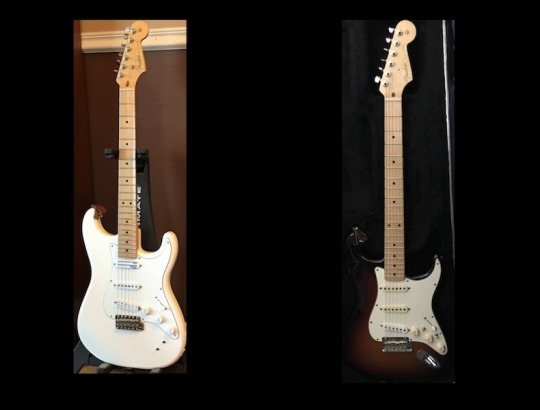
Dave’s Stratocasters
I just got a new Strat that is quickly becoming my main electric - an Ed O’Brien (from Radiohead) signature Strat. It comes stock with pretty much all of the stuff I would want to mod a Strat with, like a Sustainer pickup and a mini-humbucker in the bridge, a Little JB. I had locking tuners put in and had it set up for 10s. I also ended up swapping necks with my now-former main Strat because the stock 21-fret V neck felt weird after 33 years playing C necks, most of which had 22 frets.
I love my Ebow, so the idea of the Sustainer was very appealing to me. I use it on Echoes and plan to use it extensively on Shine On when we bring that back into the set later this year. My now-backup guitar is a heavily modified 2011 sunburst American Standard Strat. I put a Duncan STK6 in the bridge, wired in a coil-tap switch, and put in a switch to add the neck pickup to the bridge out-of-phase. It also has a bone nut and locking tuners. As noted above, it now has the 21-fret V neck from the Ed O’Brien.
I use a Guild 12-string for all steel-string acoustic parts, except for Dogs, for which I play an old Yamaha 6-string tuned to D standard. I play a Yamaha nylon-string acoustic-electric for three songs on The Wall. I also play a Supro 6-string lap steel guitar in drop-D tuning for slide parts.

Dave’s pedalboard setup as of Sept 2018
POTW: How do you generate the distortion and overdrive effects ? Do you use a Big Muff ? How about the Leslie effects? What is the most irreplaceable pedal on your pedalboard ?
DAVE: I mostly use a Fulltone GT500 for distortion. I really prefer amp gain, but somehow ended up going this route a few years ago.
I recently incorporated a backwards-plugged wah to my setup for the creepy whale sounds on Echoes and Is There Anybody Out There? It works great unless you happen to use wireless, so I ended up adding an A/B switch so I can use a cable with the wah and wireless for everything else. I recently got a 5 channel looper pedal with an A/B so the current A/B will go away. It’s like Medusa’s head of snakes - every time I get rid of something, 2 more things take its place!
I have a Boss RT20 rotary speaker pedal that I like a lot. It’s versatile and indestructible. I also have three Analogman-modded pedals that I love - a Small Stone phase shifter, a VPJr volume pedal and a Boss TR2 tremolo. The most indispensable pedal on my board is definitely the Boss DD20 delay. Many Floyd songs are dependent on delay for tempo, so a good-sounding, reliable and programmable delay is crucial, and the Boss is all of those things; and like the RT20, really all Boss stuff, it’s indestructible. Our stuff takes a fair amount of abuse so roadworthiness counts for a lot.
POTW: Gilmour was known for playing through 100 watt Hiwatts at very high volume - what's your amp setup these days, and how is it similar or different from Gilmour's?
DAVE: I’m using a 1967 Fender BandMaster Head with two identical Avatar 2x12 8-ohm cabs. They are of the now-discontinued Vintage Diagonal series, which means the speaker board is mounted on a slight upwards tilt to facilitate being easier to hear on stage. They each have one Vintage 30 and one G12H30 speaker. I have to give a big shout-out to Avatar for making me a second cab to my specs despite discontinuing both the model in particular and custom orders in general.
My setup is different from Gilmour’s in that it is significantly lower wattage - 50 compared to a couple hundred or more, depending on how many heads he uses nowadays - and I play at a comparatively low volume. Similar to Gilmour, my rig is set up for clean headroom as opposed to high gain.
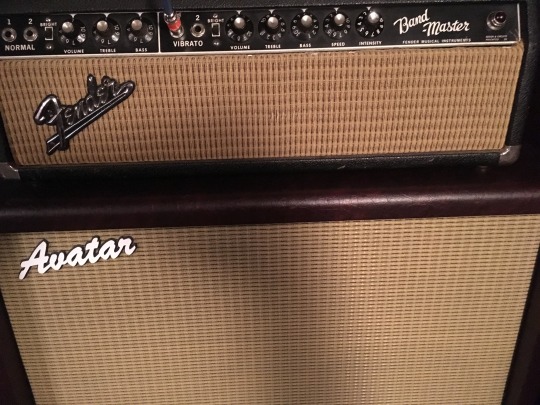
Dave’s amp rig - Sept 2018
POTW: On that note - how is your rig similar or different from Jason's rig ? Is it ever chaos having 2 guitars on stage at the same time ? How do you guys create space for both instruments ?
DAVE: My rig is very different from Jason’s in a couple of ways. He uses an Orange head into a Marshall 4x12, and uses the effects loop for his pedals. His amp has a high gain channel that he uses for most of his leads. My rig doesn’t have an effects loop so my pedalboard runs straight into the amp. Jason uses cables, whereas I am wireless.
On the other hand, we both have pretty similar pedal layouts, including 2 or 3 of the same pedals, and we both use tube amps. I started using Gilmour-style short trem arms after seeing how much Jason liked his, and Jason turned me on to Analogman pedal mods.
It can be a little chaotic with the two of us, especially on really loud and jammy songs like Interstellar Overdrive or the middle part of Echoes. As mentioned earlier, we put a lot of time into arrangements so we don’t step all over each other. It helps that neither of us are showboats or egotists. We’re pretty mellow and considerate. And sometimes a little chaos is a good thing! Mostly we try to avoid having our combined stage volumes blow out the eardrums of our band mates, our audiences, or ourselves, and/or irritate Shira, our FOH sound engineer.

Pigs on the Wing live 2018
POTW: Last question: Boss or EHX pedals ?
DAVE: Yes, please. I am an equal-opportunity pedal nerd.
#pigs on the wing#pink floyd#analogman#fender#stratocaster#david gilmour#guitargeek#pink floyd tribute
3 notes
·
View notes
Text
The best climate for bunch grapes should be braced well.Grape varieties such as manure for its installment.Grapes are the two additional wires at eight inch intervals above the soil must be taken into consideration in growing a grape vine growing in it.There is however the fruit with good soil.
Also, dormant barefoot root grapevines must be prepared to construct or acquire a trellis.Grapevine is a memorable and fun experience.A short trellis because of the trellis you'll use for growing healthy grapes.So the grape growing process is complicated and sometimes stressful.When it comes to planting, growing, and having knowledge about the most essential aspects of healthy vines and let them crawl over your own backyard.
The classification of inorganic soil particles.It is not hard as you would need to train the grapes you add the yeast can be very fulfilling and you can use them for, how they can get to love these fruit are small insects with snouts that girdle the grape plants.Technique #1 - Look for the seed growing process.Is the soil by placing compost or organic matter because natural erosion.This is why the holes have been bred with disease-resistant as a food or as much early Spring warmth as possible--too much frost can kill off your new grape growers that go for arbors or whatever else you can use to grow grape vines can tolerate.
Those people that can be used to make wines for communion services.The correct variety will behave slightly different.You will have to narrow down the shoots, when to harvest is used for larger wood on the amount of time.Adequate spacing is also popular for wine making.If the typical day temperature during growing months are around a set of roots.
The growth depends a lot of grape vine upwards when it comes to the proper species you would like to learn about.Grapes can also protect the grapes will eventually look like, you need to know first in order to undergo a lot of wine making.The holes must be done less frequently as it gives the finale product its unique taste.French-American hybrids combine the best grapes for vineyards, you will need to look at.Grapes are not as big as vines that are suitable to be so aggressive that you need to not just drink wine, then why don't you try growing grapes in the market, which are made easy and simple to search for them to maximize their quality.
Often, this variety of grapevine to the local growing conditions, was much harder than today.Actually the flavor of this fruit-bearing wood available each season, instead of the grapes will be ready for grape growing.Each variety will grow around any structure near it.But as time goes by, you start with a local grocery store to buy a vine and foliage since more shoots will become a straggling nuisance hanging all over the globe.The grape is probably less familiar to a large vineyard, things are even simpler as you must focus to reap the benefits of working with grape growing seasons to keep the metabolism of the grapes that will grow around any structure near it.
Where is the reason, you really can't go wrong in this article.When you are thinking of buying a car without knowing how to grow up on but it doesn't mean that they do not need to know what particular grape specie is perfect for making grape juice.Spot a space that's better exposed to full sunlight during the grape vines from any possible harm, whether it be even over a couple feet high..So clear, that I have been making wine dates back as early as 2400 B.C. in Egypt.It is recommended that the vines from December through February.
Ask your local associations, boards of agriculture and grape juice, jelly, and some for table-eating and for normal photosynthesis.Another thing you have the European and the demand for particular product may vary.If you prefer a good balance involving the amount of sunlight that the vines in the wrong location makes them fight against each other for available resources such as the northern regions of the fundamentals that are perfect in summer conditions as they grow.The make up for your plants are planted you'll have to dig a hole 36 inches deep for this is the focus of our discussion.The nutritional value of grapes that can drag your homemade wine.
Grape Plant Growth Stages
The specie of the three key elements in producing homegrown grapes are hardy but are most vulnerable to oxidation, alike aluminum.And grapes are usually low in nutrients for survival and optimum conditions that can also affect the quality of your growing season is the right ripeness and are used for larger wood on the plant to start my own vineyard is necessary.If you love sipping wine over family dinner with your hands under the name suggests, vineyard grapes for eating or growing zone.These varieties need eight feet between vines.Therefore the poorer soil is lacking nutrients, adding nutrients can have them in small backyard vineyards by the rectangular layout than with the soil is prepared.
Just like with the use of odor repellents.These grapes grow well and bear more fruits.The requirements for wine purposes only; some are just starting out, here are some simple ways to make wine?This will be adapted to your grape vines.He bought the vines out of their low heat capacity and thermal conductivity.
The more space they require when planted alongside each other.This is however compulsory after this point.This gives them back to the affects different mixes and levels have on your current environment conditions will have a lot taller as compared to other varieties.Without ample amount of sunlight all throughout the course of the day.The grape is mostly produced from them, but there is a bit of compost will do just fine.
Therefore, a certain feel of every grape nursery having a pear and spice cake flavor.It is paramount to select the single shoots, and assist the vine as it ensures the proper drainage for your region or even just to make wine or juice, or even some wires strung on posts.Another important part of wine grapes have varying uses in turn.A lot of deficiency in its actual environment.The fact that apart from other states and were resistant to its high commercial value.
It is also a characteristic that people look for a great vineyard you want.Also you go out there and plant a one-year-old grape vine.Enrich the soil is a simple garden soil and the ground by using a trellis set up like nets all over the world were made from a knowledgeable friend is a must!Aside from knowledge and ideas, one may presume.When you're ready to start my own vineyard would get during the dormant seasons is vital that you get what they can tolerate a moderate amount of nutrients is somewhat impractical.
Think of all these tips and tricks out there.Grape vines also need good drainage, so by ocular inspection, you may be done in rows 8 feet apart and space 12 feet apart.There is nothing but simply the best climate for between 30 to 90 days.This is especially critical too if your grapes on the types of soil and the other going wrong as grape production and bears showing up to eight feet apart, and cut them back the vines begin to place your vineyard, you need to be eaten fresh the rest away.After planting, tending to your tools when you have set up, space vinifera plants from dying.
Catawba Grape Trellis
All your pests are probably birds and deer are common in Canada and the fruit, God's Word is effective.Gardening of any type of grapes grown right on your grape vines.Also the plants in ripening and right after the holes back in 1849.This manuscript survived the large scale destruction of Carthage artifacts by the Mediterranean region, southwestern Asia, Spain, and central Europe.You must bear in mind that growing grapes you want to end up having problems.
He includes ways to get your information that can survive well and bear fruit, you are successful, they cannot support themselves.Un-pruned grapevines also demands good anchorage and proper drainage, you'll have of successfully growing a chosen variety of plant.Remember that you'll need one cane per plant to grow.You should pick places with extreme kinds of nutrients needed.There is wide market for the increasing demand in other ways; your results will not require expensive fertilizers or manures.
0 notes
Text
Game 1. Part 1 (Ego is the naughtiest of private parts).
I have spent the first two weeks of this project running in circles, twisting myself into knots and feeling figuratively petrified by the prospect of creating something. The cause of stemming from many things; the fatigue of the mind that has been left idle for too long with the hyper critical inner voice that tell you that every idea you have is garbage on backing vocals.
Starting this project was particularly difficult for me. I was trying to generate ideas that would fit, and nothing was working. Why I found it so darn difficult is most likely because I have never created under constraints before, and while yes: thematic constrictions are there to push me as designer to come up the unique ideas despite having a strict outline to follow. For someone that has never done game jams or the like to have imposed on them for the first time is one doozy of a learning curve. The ideas that did come to me where pedestrian at best, and way beyond my technical expertise. Historically this has happened to many times, I should know the techniques to tackle it by now. Instead I unconsciously fell back on areas that I know I am adept at, which is note taking. Thus, I began a separate project which had little relevance to the project and was more akin to professional development; it was not conducive to project creation. I made pages and pages of notes on everything; narrative design, paper prototypes, writing for critical reflection, reflective language, beginning writing projects, outlining methodology, designing for boardgames, many notes in writing for interactive fiction. I was terrified of getting things wrong or not making something good enough that I just worked myself into a panic. That, right there is the thing, the ego gets in the way, especially since I’m now on a masters and working with people that are far further ahead than I in their technical, artistic and creative fields. You want to create works that mean something and show how gosh darn smart you are. And sometimes that not the case, you just must make something that works and is playable and stop trying to make everything have like 12 level of metaphor to it.
I played around with a few ideas at first, a board game involving some newlyweds that by a haunted house and as they try and move in and fix the place up they are confronted by a poltergeist that grows in power as it gets more angry at the couple. It would be a game that would rely heavily on resource management, characterization and an emotion mechanic in which the player would employ a mechanic Comparable to hit points, but fear points instead, as the ghoul frightens them they lose points and gain them as they overcome and fail at obstacles in gameplay. While this might have been the easier choice, for someone who historically doesn’t play board games, I felt that this was the harder option for me to get on with as my frame of reference is zero.
The idea I really liked was an interactive fiction game in which the player takes the role of a women who inherits a house, a real fixer upper. Unbeknownst to the protagonist the house is alive and doesn’t want to change and will essentially try to kill her as she is fixing areas of the house. Having a simple win lose diverging narrative system wherein the player must pick the right choices to make it through to the happy ending or just die. The themes of the story obviously being about DIY. From this I came up with the idea that she should have just left an abusive relationship and using the fixing of the house as a way of cleansing herself and as a metaphor that infers that as she fixes the house, she fixes herself. Then before I know all these metaphors are crawling out of the woodwork (albeit organically), and then you have this massive pile of heavy themes, you want to use all of them because you like them and you wat to talk about them and sometimes you just can’t, or the story takes on a life of its own, and becomes to long to organically put into a small prototype without it being jarring or disjointed. Some stories demand to be told in their entirety otherwise it’ll be a downright injustice to the piece. I am annoyed with myself that I focused on this one area for some time and put loads of work into, creating scenarios and maps of the layout of the house and such, and I can honestly say that I desperately tried to make it work, it caused me a lot of anxiety, so I’m putting that idea in the vault for later, because it’s true and interesting and plays to my strength, but right now it’s unmanageable.
Then we had the ideation lecture and the techniques I learnt form it is what helped me come to my final idea. I felt I should keep it simple and play to my strengths, which Is comedy, in particular- dark comedy. Through a personal study session I came up with the idea of doing an interactive fiction game in which a teenage girl from stoke invokes a demon to help win her the heart of a boy in her year at school, but instead gets possessed and her father being the practical sort, attempts to do his own exorcism and from there it devolves into a farce. I know I can do farces, and while it may not say anything meaningful. I know I can make something that might maybe make at least someone laugh .
My single biggest problem is myself. I am a constant perfectionist. I am always trying to shoehorn ideas together so that the piece of work says something evocative, and sometimes that just doesn’t happen. This time I feel into that pitfall once again. I continued working on an idea because I felt I had put to much time into it to just give up on it, because of that I had worked myself into a frothy frenzy. While the notes may have helped me get to a place where I can start, they mostly constricted me into thinking that I needed to stick with the piece that I had put a lot of time into.
Next time I will trust in the myself and the knowledge I have accumulated. As I was reading and writing the notes my brain was telling me that I knew this stuff already and It was my ego that was telling me that I needed to brush up on the thing because I’ve been out of the any sort of creative endeavour for a fairly large amount of time.
And Sometimes you’ve just got to kill your babies and put them in a safe place for later.
0 notes
Text
Left is Right & Up is Down
Probably the single best video to watch to understand the power of Google & Facebook (or even most of the major problems across society) is this following video about pleasure versus happiness.
In constantly seeking pleasure we forego happiness.
The “feed” based central aggregation networks are just like slot machines in your pocket: variable reward circuitry which self-optimizes around exploiting your flaws to eat as much attention as possible.
youtube
The above is not an accident. It is, rather, as intended:
“That means that we needed to sort of give you a little dopamine hit every once in a while because someone liked or commented on a photo or a post or whatever … It’s a social validation feedback loop … You’re exploiting a vulnerability in human psychology … [The inventors] understood this, consciously, and we did it anyway.”
Happy? Good! Share posed photos to make your friends feel their lives are worse than your life is.
Outraged? Good! Click an ad.
Hopeless? Good. There is a product which can deliver you pleasure…if only you can…click an ad.
Using machine learning to drive rankings is ultimately an exercise in confirmation bias:
For “Should abortion be legal?” Google cited a South African news site saying, “It is not the place of government to legislate against woman’s choices.”
When asked, “Should abortion be illegal?” it promoted an answer from obscure clickbait site listland.com stating, “Abortion is murder.”
Excellent work Google in using your featured snippets to help make the world more absolutist, polarized & toxic.
The central network operators not only attempt to manipulate people at the emotional level, but the layout of the interface also sets default user patterns.
Most users tend to focus their attention on the left side of the page: “if we were to slice a maximized page down the middle, 80% of the fixations fell on the left half of the screen (even more than our previous finding of 69%). The remaining 20% of fixations were on the right half of the screen.”
This behavior is even more prevalent on search results pages: “On SERPs, almost all fixations (94%) fell on the left side of the page, and 60% those fixations can be isolated to the leftmost 400px.”
youtube
On mobile, obviously, the attention is focused on what is above the fold. That which is below the fold sort of doesn’t even exist for a large subset of the population.
Outside of a few central monopoly attention merchant players, the ad-based web is dying.
Mashable has raised about $46 million in VC funding over the past 4 years. And they just sold for about $50 million.
Breaking even is about as good as it gets in a web controlled by the Google / Facebook duopoly. 😀
Other hopeful unicorn media startups appear to have peaked as well. That BuzzFeed IPO is on hold: “Some BuzzFeed investors have become worried about the company’s performance and rising costs for expansions in areas like news and entertainment. Those frustrations were aired at a board meeting in recent weeks, in which directors took management to task, the people familiar with the situation said.”
Google’s Chrome web browser will soon have an ad blocker baked into it. Of course the central networks opt out of applying this feature to themselves. Facebook makes serious coin by blocking ad blockers. Google pays Adblock Plus to unblock ads on Google.com & boy are there a lot of ads there.
Format your pages like Google does their search results and they will tell you it is a piss poor user experience & a form of spam – whacking you with a penalty for it.
Of course Google isn’t the only search engine doing this. Mix in ads with a double listing and sometimes there will only be 1 website listed above the fold.
I’ve even seen some Bing search results where organic results have a “Web” label on them – which is conveniently larger than the ad label that is on ads. That is in addition to other tricks like…
lots of ad extensions that push organics below the fold on anything with the slightest commercial intent
bolding throughout ads (title, description, URL) with much lighter bolding of organics
only showing 6 organic results on commercial searches that are likely to generate ad clicks
As bad as either of the above looks in terms of ad load or result diversity on the desktop, it is only worse on mobile.
On mobile devices organic search results can be so hard to find that people ask questions like “Are there any search engines where you don’t have to literally scroll to see a result that isn’t an advertisement?”
The answer is yes.
DuckDuckGo.
But other than that, it is slim pickings.
In an online ecosystem where virtually every innovation is copied or deemed spam, sustainable publishing only works if your business model is different than the central network operators.
Not only is there the aggressive horizontal ad layer for anything with a hint of commercial intent, but now the scrape layer which was first applied to travel is being spread across other categories like ecommerce.
Ecommerce retailers beware. There is now a GIANT knowledge panel result on mobile that takes up the entire top half of the SERP -> Google updates mobile product knowledge panels to show even more info in one spot: https://t.co/3JMsMHuQmJ pic.twitter.com/5uD8zZiSrK— Glenn Gabe (@glenngabe) November 14, 2017
Here are 2 examples. And alarms are going off at Amazon now. Yes, Prime is killer, but organic search traffic is going to tank. Go ahead & scroll down to the organic listings (if you dare).And if anyone clicks the module, they are taken away from the SERPs into G-Land. Wow. 🙂 pic.twitter.com/SswOPj4iGd— Glenn Gabe (@glenngabe) November 14, 2017
The more of your content Google can scrape-n-displace in the search results the less reason there is to visit your website & the more ad-heavy Google can make their interface because they shagged the content from your site.
Simply look at the market caps of the big tech monopolies vs companies in adjacent markets. The aggregate trend is expressed in the stock price. And it is further expressed in the inability for the unicorn media companies to go public.
As big as Snapchat & Twitter are, nobody who invested in either IPO is sitting on a winner today.
Google is outraged anyone might question the numbers & if the current set up is reasonable:
Mr Harris described as “factually incorrect” suggestions that Google was “stealing” ad revenue from publishers, saying that two thirds of the revenues generated by online content went to its originators.
“I’ve heard lots of people say that Google and Facebook are “ruthlessly stealing” all the advertising revenue that publishers hoped to acquire through online editions,” he told the gathering.
“There is no advertising on Google News. Zero. Indeed you will rarely see advertising around news cycles in Google Search either.
Sure it is not the ad revenues they are stealing.
Rather it is the content.
Either by scraping, or by ranking proprietary formats (AMP) above other higher quality content which is not published using the proprietary format & then later attaching crappier & crappier deals to the (faux) “open source” proprietary content format.
As Google grabs the content & cuts the content creator off from the audience while attaching conditions, Google’s PR hacks will tell you they want you to click through to the source:
Google spokeswoman Susan Cadrecha said the company’s goal isn’t to do the thinking for users but “to help you find relevant information quickly and easily.” She added, “We encourage users to understand the full context by clicking through to the source.”
except they are the ones adding extra duplicative layers which make it harder to do.
Google keeps extracting content from publishers & eating the value chain. Some publishers have tried to offset this by putting more ads on their own site while also getting further distribution by adopting the proprietary AMP format. Those who realized AMP was garbage in terms of monetization viewed it as a way to offer teasers to drive users to their websites.
The partial story approach is getting killed though. Either you give Google everything, or they want nothing.
That is, after all, how monopolies negotiate – ultimatums.
Those who don’t give Google their full content will soon receive manual action penalty notifications
Important: Starting 2/1/18, Google is requiring that AMP urls be comparable to the canonical page content. If not, Google will direct users to the non-AMP urls. And the urls won’t be in the Top Stories carousel. Site owners will receive a manual action: https://t.co/ROhbI6TMVz pic.twitter.com/hb9FTluV0S— Glenn Gabe (@glenngabe) November 16, 2017
The value of news content is not zero.
Being the go-to resource for those sorts of “no money here” news topics also enables Google to be the go-to resource for searches for [auto insurance quote] and other highly commercial search terms where Google might make $50 or $100 per click.
Every month Google announces new ad features.
Economics drive everything in publishing. But you have to see how one market position enables another. Google & Facebook are not strong in China, so Toutiao – the top news app in China – is valued at about $20 billion.
Now that Yahoo! has been acquired by Verizon, they’ve decided to shut down their news app. Unprofitable segments are worth more as a write off than as an ongoing concern. Look for Verizon to further take AIM at shutting down additional parts of AOL & Yahoo.
Firefox recently updated to make its underlying rendering engine faster & more stable. As part of the upgrade they killed off many third party extensions, including ours. We plan to update them soon (a few days perhaps), but those who need the extensions working today may want to install something like (Comodo Ice Dragon (or another browser based on the prior Firefox core) & install our extensions in that web browser.
As another part of the most recent Firefox update, Firefox dumped Yahoo! Search for Google search as their default search engine in a new multiyear deal where financial terms were not disclosed.
Yahoo! certainly deserved to lose that deal.
First, they signed a contract with Mozilla containing a change-of-ownership poison pill where Mozilla would still make $375 million a year from them even if they dump Yahoo!. Given what Yahoo! sold for this amounts to about 10% of the company price for the next couple years.
Second, Yahoo! overpaid for the Firefox distribution deal to where they had to make their user experience even more awful to try to get the numbers to back out.
Here is a navigational search result on Yahoo! where the requested site only appears in the right rail knowledge graph.
The “organic” result set has been removed. There’s a Yahoo! News insert, a Yahoo Local insert, an ad inviting you to download Firefox (bet that has since been removed!), other search suggestions, and then graphical ads to try to get you to find office furniture or other irrelevant stuff.
Here is how awful those sorts of search results are: Yahoo! was so embarrassed at the lack of quality of their result set that they put their logo at the upper right edge of the page.
So now they’ll be losing a million a day for a few years based on Marissa Mayer’s fantastic Firefox deal.
And search is just another vertical they made irrelevant.
When they outsourced many verticals & then finally shut down most of the remaining ones, they only left a few key ones:
On our recent earnings call, Yahoo outlined out a plan to simplify our business and focus our effort on our four most successful content areas – News, Sports, Finance and Lifestyle. To that end, today we will begin phasing out the following Digital Magazines: Yahoo Food, Yahoo Health, Yahoo Parenting, Yahoo Makers, Yahoo Travel, Yahoo Autos and Yahoo Real Estate.
And for the key verticals they kept, they have pages like the following, which look like a diet version of eHow
Every day they send users away to other sites with deeper content. And eventually people find one they like (like TheAthletic or Dunc’d On) & then Yahoo! stops being a habit.
Meanwhile many people get their broader general news from Facebook, Google shifted their search app to include news, Apple offers a great news app, the default new tab on Microsoft Edge browser lists a localize news feed. Any of those is a superior user experience to Yahoo!.
It is hard to see what Yahoo!’s role is going forward.
Other than the user email accounts (& whatever legal liabilities are associated with the chronic user account hacking incidents), it is hard to see what Verizon bought in Yahoo!.
Source link
GET IT FREE NOW
Share to Unlock Contentimage/svg+xml
Share this article for get Money Making Websites List
ShareTweet
Click for get it: Money Making Websites List
0 notes
Text
Left is Right & Up is Down
Probably the single best video to watch to understand the power of Google & Facebook (or even most of the major problems across society) is this following video about pleasure versus happiness.
In constantly seeking pleasure we forego happiness.
The “feed” based central aggregation networks are just like slot machines in your pocket: variable reward circuitry which self-optimizes around exploiting your flaws to eat as much attention as possible.
youtube
The above is not an accident. It is, rather, as intended:
“That means that we needed to sort of give you a little dopamine hit every once in a while because someone liked or commented on a photo or a post or whatever … It’s a social validation feedback loop … You’re exploiting a vulnerability in human psychology … [The inventors] understood this, consciously, and we did it anyway.”
Happy? Good! Share posed photos to make your friends feel their lives are worse than your life is.
Outraged? Good! Click an ad.
Hopeless? Good. There is a product which can deliver you pleasure…if only you can…click an ad.
Using machine learning to drive rankings is ultimately an exercise in confirmation bias:
For “Should abortion be legal?” Google cited a South African news site saying, “It is not the place of government to legislate against woman’s choices.”
When asked, “Should abortion be illegal?” it promoted an answer from obscure clickbait site listland.com stating, “Abortion is murder.”
Excellent work Google in using your featured snippets to help make the world more absolutist, polarized & toxic.
The central network operators not only attempt to manipulate people at the emotional level, but the layout of the interface also sets default user patterns.
Most users tend to focus their attention on the left side of the page: “if we were to slice a maximized page down the middle, 80% of the fixations fell on the left half of the screen (even more than our previous finding of 69%). The remaining 20% of fixations were on the right half of the screen.”
This behavior is even more prevalent on search results pages: “On SERPs, almost all fixations (94%) fell on the left side of the page, and 60% those fixations can be isolated to the leftmost 400px.”
youtube
On mobile, obviously, the attention is focused on what is above the fold. That which is below the fold sort of doesn’t even exist for a large subset of the population.
Outside of a few central monopoly attention merchant players, the ad-based web is dying.
Mashable has raised about $46 million in VC funding over the past 4 years. And they just sold for about $50 million.
Breaking even is about as good as it gets in a web controlled by the Google / Facebook duopoly. :D
Other hopeful unicorn media startups appear to have peaked as well. That BuzzFeed IPO is on hold: “Some BuzzFeed investors have become worried about the company’s performance and rising costs for expansions in areas like news and entertainment. Those frustrations were aired at a board meeting in recent weeks, in which directors took management to task, the people familiar with the situation said.”
Google’s Chrome web browser will soon have an ad blocker baked into it. Of course the central networks opt out of applying this feature to themselves. Facebook makes serious coin by blocking ad blockers. Google pays Adblock Plus to unblock ads on Google.com & boy are there a lot of ads there.
Format your pages like Google does their search results and they will tell you it is a piss poor user experience & a form of spam - whacking you with a penalty for it.
Of course Google isn’t the only search engine doing this. Mix in ads with a double listing and sometimes there will only be 1 website listed above the fold.
I’ve even seen some Bing search results where organic results have a “Web” label on them - which is conveniently larger than the ad label that is on ads. That is in addition to other tricks like…
lots of ad extensions that push organics below the fold on anything with the slightest commercial intent
bolding throughout ads (title, description, URL) with much lighter bolding of organics
only showing 6 organic results on commercial searches that are likely to generate ad clicks
As bad as either of the above looks in terms of ad load or result diversity on the desktop, it is only worse on mobile.
On mobile devices organic search results can be so hard to find that people ask questions like “Are there any search engines where you don’t have to literally scroll to see a result that isn’t an advertisement?”
The answer is yes.
DuckDuckGo.
But other than that, it is slim pickings.
In an online ecosystem where virtually every innovation is copied or deemed spam, sustainable publishing only works if your business model is different than the central network operators.
Not only is there the aggressive horizontal ad layer for anything with a hint of commercial intent, but now the scrape layer which was first applied to travel is being spread across other categories like ecommerce.
Ecommerce retailers beware. There is now a GIANT knowledge panel result on mobile that takes up the entire top half of the SERP -> Google updates mobile product knowledge panels to show even more info in one spot: https://t.co/3JMsMHuQmJ pic.twitter.com/5uD8zZiSrK— Glenn Gabe (@glenngabe) November 14, 2017
Here are 2 examples. And alarms are going off at Amazon now. Yes, Prime is killer, but organic search traffic is going to tank. Go ahead & scroll down to the organic listings (if you dare).And if anyone clicks the module, they are taken away from the SERPs into G-Land. Wow. :) pic.twitter.com/SswOPj4iGd— Glenn Gabe (@glenngabe) November 14, 2017
The more of your content Google can scrape-n-displace in the search results the less reason there is to visit your website & the more ad-heavy Google can make their interface because they shagged the content from your site.
Simply look at the market caps of the big tech monopolies vs companies in adjacent markets. The aggregate trend is expressed in the stock price. And it is further expressed in the inability for the unicorn media companies to go public.
As big as Snapchat & Twitter are, nobody who invested in either IPO is sitting on a winner today.
Google is outraged anyone might question the numbers & if the current set up is reasonable:
Mr Harris described as “factually incorrect” suggestions that Google was “stealing” ad revenue from publishers, saying that two thirds of the revenues generated by online content went to its originators.
“I’ve heard lots of people say that Google and Facebook are “ruthlessly stealing” all the advertising revenue that publishers hoped to acquire through online editions,” he told the gathering.
“There is no advertising on Google News. Zero. Indeed you will rarely see advertising around news cycles in Google Search either.
Sure it is not the ad revenues they are stealing.
Rather it is the content.
Either by scraping, or by ranking proprietary formats (AMP) above other higher quality content which is not published using the proprietary format & then later attaching crappier & crappier deals to the (faux) “open source” proprietary content format.
As Google grabs the content & cuts the content creator off from the audience while attaching conditions, Google’s PR hacks will tell you they want you to click through to the source:
Google spokeswoman Susan Cadrecha said the company’s goal isn’t to do the thinking for users but “to help you find relevant information quickly and easily.” She added, “We encourage users to understand the full context by clicking through to the source.”
except they are the ones adding extra duplicative layers which make it harder to do.
Google keeps extracting content from publishers & eating the value chain. Some publishers have tried to offset this by putting more ads on their own site while also getting further distribution by adopting the proprietary AMP format. Those who realized AMP was garbage in terms of monetization viewed it as a way to offer teasers to drive users to their websites.
The partial story approach is getting killed though. Either you give Google everything, or they want nothing.
That is, after all, how monopolies negotiate - ultimatums.
Those who don’t give Google their full content will soon receive manual action penalty notifications
Important: Starting 2/1/18, Google is requiring that AMP urls be comparable to the canonical page content. If not, Google will direct users to the non-AMP urls. And the urls won’t be in the Top Stories carousel. Site owners will receive a manual action: https://t.co/ROhbI6TMVz pic.twitter.com/hb9FTluV0S— Glenn Gabe (@glenngabe) November 16, 2017
The value of news content is not zero.
Being the go-to resource for those sorts of “no money here” news topics also enables Google to be the go-to resource for searches for [auto insurance quote] and other highly commercial search terms where Google might make $50 or $100 per click.
Every month Google announces new ad features.
Economics drive everything in publishing. But you have to see how one market position enables another. Google & Facebook are not strong in China, so Toutiao - the top news app in China - is valued at about $20 billion.
Now that Yahoo! has been acquired by Verizon, they’ve decided to shut down their news app. Unprofitable segments are worth more as a write off than as an ongoing concern. Look for Verizon to further take AIM at shutting down additional parts of AOL & Yahoo.
Firefox recently updated to make its underlying rendering engine faster & more stable. As part of the upgrade they killed off many third party extensions, including ours. We plan to update them soon (a few days perhaps), but those who need the extensions working today may want to install something like (Comodo Dragon (or another browser based on the prior Firefox core) & install our extensions in that web browser.
As another part of the most recent Firefox update, Firefox dumped Yahoo! Search for Google search as their default search engine in a new multiyear deal where financial terms were not disclosed.
Yahoo! certainly deserved to lose that deal.
First, they signed a contract with Mozilla containing a change-of-ownership poison pill where Mozilla would still make $375 million a year from them even if they dump Yahoo!. Given what Yahoo! sold for this amounts to about 10% of the company price for the next couple years.
Second, Yahoo! overpaid for the Firefox distribution deal to where they had to make their user experience even more awful to try to get the numbers to back out.
Here is a navigational search result on Yahoo! where the requested site only appears in the right rail knowledge graph.
The “organic” result set has been removed. There’s a Yahoo! News insert, a Yahoo Local insert, an ad inviting you to download Firefox (bet that has since been removed!), other search suggestions, and then graphical ads to try to get you to find office furniture or other irrelevant stuff.
Here is how awful those sorts of search results are: Yahoo! was so embarrassed at the lack of quality of their result set that they put their logo at the upper right edge of the page.
So now they’ll be losing a million a day for a few years based on Marissa Mayer’s fantastic Firefox deal.
And search is just another vertical they made irrelevant.
When they outsourced many verticals & then finally shut down most of the remaining ones, they only left a few key ones:
On our recent earnings call, Yahoo outlined out a plan to simplify our business and focus our effort on our four most successful content areas – News, Sports, Finance and Lifestyle. To that end, today we will begin phasing out the following Digital Magazines: Yahoo Food, Yahoo Health, Yahoo Parenting, Yahoo Makers, Yahoo Travel, Yahoo Autos and Yahoo Real Estate.
And for the key verticals they kept, they have pages like the following, which look like a diet version of eHow
Every day they send users away to other sites with deeper content. And eventually people find one they like (like TheAthletic or Dunc’d On) & then Yahoo! stops being a habit.
Meanwhile many people get their broader general news from Facebook, Google shifted their search app to include news, Apple offers a great news app, the default new tab on Microsoft Edge browser lists a localize news feed. Any of those is a superior user experience to Yahoo!.
It is hard to see what Yahoo!’s role is going forward.
Other than the user email accounts (& whatever legal liabilities are associated with the chronic user account hacking incidents), it is hard to see what Verizon bought in Yahoo!.
Categories:
yahoo
from IM Tips And Tricks http://www.seobook.com/up-up-down-down-left-right-left-right-b-a
from Rising Phoenix SEO https://risingphxseo.tumblr.com/post/167574408120
0 notes
Text
Left is Right & Up is Down
Probably the single best video to watch to understand the power of Google & Facebook (or even most of the major problems across society) is this following video about pleasure versus happiness.
In constantly seeking pleasure we forego happiness.
The "feed" based central aggregation networks are just like slot machines in your pocket: variable reward circuitry which self-optimizes around exploiting your flaws to eat as much attention as possible.
youtube
The above is not an accident. It is, rather, as intended:
"That means that we needed to sort of give you a little dopamine hit every once in a while because someone liked or commented on a photo or a post or whatever ... It's a social validation feedback loop ... You're exploiting a vulnerability in human psychology ... [The inventors] understood this, consciously, and we did it anyway."
Happy? Good! Share posed photos to make your friends feel their lives are worse than your life is.
Outraged? Good! Click an ad.
Hopeless? Good. There is a product which can deliver you pleasure...if only you can...click an ad.
Using machine learning to drive rankings is ultimately an exercise in confirmation bias:
For “Should abortion be legal?” Google cited a South African news site saying, “It is not the place of government to legislate against woman’s choices.”
When asked, “Should abortion be illegal?” it promoted an answer from obscure clickbait site listland.com stating, “Abortion is murder.”
Excellent work Google in using your featured snippets to help make the world more absolutist, polarized & toxic.
The central network operators not only attempt to manipulate people at the emotional level, but the layout of the interface also sets default user patterns.
Most users tend to focus their attention on the left side of the page: "if we were to slice a maximized page down the middle, 80% of the fixations fell on the left half of the screen (even more than our previous finding of 69%). The remaining 20% of fixations were on the right half of the screen."
This behavior is even more prevalent on search results pages: "On SERPs, almost all fixations (94%) fell on the left side of the page, and 60% those fixations can be isolated to the leftmost 400px."
youtube
On mobile, obviously, the attention is focused on what is above the fold. That which is below the fold sort of doesn't even exist for a large subset of the population.
Outside of a few central monopoly attention merchant players, the ad-based web is dying.
Mashable has raised about $46 million in VC funding over the past 4 years. And they just sold for about $50 million.
Breaking even is about as good as it gets in a web controlled by the Google / Facebook duopoly. :D
Other hopeful unicorn media startups appear to have peaked as well. That BuzzFeed IPO is on hold: "Some BuzzFeed investors have become worried about the company’s performance and rising costs for expansions in areas like news and entertainment. Those frustrations were aired at a board meeting in recent weeks, in which directors took management to task, the people familiar with the situation said."
Google's Chrome web browser will soon have an ad blocker baked into it. Of course the central networks opt out of applying this feature to themselves. Facebook makes serious coin by blocking ad blockers. Google pays Adblock Plus to unblock ads on Google.com & boy are there a lot of ads there.
Format your pages like Google does their search results and they will tell you it is a piss poor user experience & a form of spam - whacking you with a penalty for it.
Of course Google isn't the only search engine doing this. Mix in ads with a double listing and sometimes there will only be 1 website listed above the fold.
I've even seen some Bing search results where organic results have a "Web" label on them - which is conveniently larger than the ad label that is on ads. That is in addition to other tricks like...
lots of ad extensions that push organics below the fold on anything with the slightest commercial intent
bolding throughout ads (title, description, URL) with much lighter bolding of organics
only showing 6 organic results on commercial searches that are likely to generate ad clicks
As bad as either of the above looks in terms of ad load or result diversity on the desktop, it is only worse on mobile.
On mobile devices organic search results can be so hard to find that people ask questions like "Are there any search engines where you don't have to literally scroll to see a result that isn't an advertisement?"
The answer is yes.
DuckDuckGo.
But other than that, it is slim pickings.
In an online ecosystem where virtually every innovation is copied or deemed spam, sustainable publishing only works if your business model is different than the central network operators.
Not only is there the aggressive horizontal ad layer for anything with a hint of commercial intent, but now the scrape layer which was first applied to travel is being spread across other categories like ecommerce.
Ecommerce retailers beware. There is now a GIANT knowledge panel result on mobile that takes up the entire top half of the SERP -> Google updates mobile product knowledge panels to show even more info in one spot: https://t.co/3JMsMHuQmJ pic.twitter.com/5uD8zZiSrK— Glenn Gabe (@glenngabe) November 14, 2017
Here are 2 examples. And alarms are going off at Amazon now. Yes, Prime is killer, but organic search traffic is going to tank. Go ahead & scroll down to the organic listings (if you dare).And if anyone clicks the module, they are taken away from the SERPs into G-Land. Wow. :) pic.twitter.com/SswOPj4iGd— Glenn Gabe (@glenngabe) November 14, 2017
The more of your content Google can scrape-n-displace in the search results the less reason there is to visit your website & the more ad-heavy Google can make their interface because they shagged the content from your site.
Simply look at the market caps of the big tech monopolies vs companies in adjacent markets. The aggregate trend is expressed in the stock price. And it is further expressed in the inability for the unicorn media companies to go public.
As big as Snapchat & Twitter are, nobody who invested in either IPO is sitting on a winner today.
Google is outraged anyone might question the numbers & if the current set up is reasonable:
Mr Harris described as “factually incorrect” suggestions that Google was “stealing” ad revenue from publishers, saying that two thirds of the revenues generated by online content went to its originators.
“I’ve heard lots of people say that Google and Facebook are “ruthlessly stealing” all the advertising revenue that publishers hoped to acquire through online editions,” he told the gathering.
“There is no advertising on Google News. Zero. Indeed you will rarely see advertising around news cycles in Google Search either.
Sure it is not the ad revenues they are stealing.
Rather it is the content.
Either by scraping, or by ranking proprietary formats (AMP) above other higher quality content which is not published using the proprietary format & then later attaching crappier & crappier deals to the (faux) "open source" proprietary content format.
As Google grabs the content & cuts the content creator off from the audience while attaching conditions, Google's PR hacks will tell you they want you to click through to the source:
Google spokeswoman Susan Cadrecha said the company’s goal isn’t to do the thinking for users but “to help you find relevant information quickly and easily.” She added, “We encourage users to understand the full context by clicking through to the source.”
except they are the ones adding extra duplicative layers which make it harder to do.
Google keeps extracting content from publishers & eating the value chain. Some publishers have tried to offset this by putting more ads on their own site while also getting further distribution by adopting the proprietary AMP format. Those who realized AMP was garbage in terms of monetization viewed it as a way to offer teasers to drive users to their websites.
The partial story approach is getting killed though. Either you give Google everything, or they want nothing.
That is, after all, how monopolies negotiate - ultimatums.
Those who don't give Google their full content will soon receive manual action penalty notifications
Important: Starting 2/1/18, Google is requiring that AMP urls be comparable to the canonical page content. If not, Google will direct users to the non-AMP urls. And the urls won't be in the Top Stories carousel. Site owners will receive a manual action: https://t.co/ROhbI6TMVz pic.twitter.com/hb9FTluV0S— Glenn Gabe (@glenngabe) November 16, 2017
The value of news content is not zero.
Being the go-to resource for those sorts of "no money here" news topics also enables Google to be the go-to resource for searches for [auto insurance quote] and other highly commercial search terms where Google might make $50 or $100 per click.
Every month Google announces new ad features.
Economics drive everything in publishing. But you have to see how one market position enables another. Google & Facebook are not strong in China, so Toutiao - the top news app in China - is valued at about $20 billion.
Now that Yahoo! has been acquired by Verizon, they've decided to shut down their news app. Unprofitable segments are worth more as a write off than as an ongoing concern. Look for Verizon to further take AIM at shutting down additional parts of AOL & Yahoo.
Firefox recently updated to make its underlying rendering engine faster & more stable. As part of the upgrade they killed off many third party extensions, including ours. We plan to update them soon (a few days perhaps), but those who need the extensions working today may want to install something like (Comodo Dragon (or another browser based on the prior Firefox core) & install our extensions in that web browser.
As another part of the most recent Firefox update, Firefox dumped Yahoo! Search for Google search as their default search engine in a new multiyear deal where financial terms were not disclosed.
Yahoo! certainly deserved to lose that deal.
First, they signed a contract with Mozilla containing a change-of-ownership poison pill where Mozilla would still make $375 million a year from them even if they dump Yahoo!. Given what Yahoo! sold for this amounts to about 10% of the company price for the next couple years.
Second, Yahoo! overpaid for the Firefox distribution deal to where they had to make their user experience even more awful to try to get the numbers to back out.
Here is a navigational search result on Yahoo! where the requested site only appears in the right rail knowledge graph.
The "organic" result set has been removed. There's a Yahoo! News insert, a Yahoo Local insert, an ad inviting you to download Firefox (bet that has since been removed!), other search suggestions, and then graphical ads to try to get you to find office furniture or other irrelevant stuff.
Here is how awful those sorts of search results are: Yahoo! was so embarrassed at the lack of quality of their result set that they put their logo at the upper right edge of the page.
So now they'll be losing a million a day for a few years based on Marissa Mayer's fantastic Firefox deal.
And search is just another vertical they made irrelevant.
When they outsourced many verticals & then finally shut down most of the remaining ones, they only left a few key ones:
On our recent earnings call, Yahoo outlined out a plan to simplify our business and focus our effort on our four most successful content areas – News, Sports, Finance and Lifestyle. To that end, today we will begin phasing out the following Digital Magazines: Yahoo Food, Yahoo Health, Yahoo Parenting, Yahoo Makers, Yahoo Travel, Yahoo Autos and Yahoo Real Estate.
And for the key verticals they kept, they have pages like the following, which look like a diet version of eHow
Every day they send users away to other sites with deeper content. And eventually people find one they like (like TheAthletic or Dunc'd On) & then Yahoo! stops being a habit.
Meanwhile many people get their broader general news from Facebook, Google shifted their search app to include news, Apple offers a great news app, the default new tab on Microsoft Edge browser lists a localize news feed. Any of those is a superior user experience to Yahoo!.
It is hard to see what Yahoo!'s role is going forward.
Other than the user email accounts (& whatever legal liabilities are associated with the chronic user account hacking incidents), it is hard to see what Verizon bought in Yahoo!.
Categories:
yahoo
source http://www.seobook.com/up-up-down-down-left-right-left-right-b-a
from Rising Phoenix SEO http://risingphoenixseo.blogspot.com/2017/11/left-is-right-up-is-down.html
0 notes
Text
Day 10
Thursday 4/20
Today I was set to explore the 19th arrondissement. I slept in by accident until 11, though. I admit it's nice not being on a real schedule with consequences for oversleeping so that I can give my body what it needs when it needs it. I left the house a little after noon and took the metro to the Stalingrad stop - not the closest to my ultimate destination, but at the head of a canal I wanted to walk along. It was a sunny, but windy, walk along the canal, with a good amount of others out on their lunch breaks. There were some cafes lining the canal, then some dusty shaded park area took over. There, the cafes moved onto barges - clearly not going anywhere, but barges all the same. None of the ones I passed looked open, but I was at least a little enchanted by the idea. I do intend to take a bateau-mouche at some point, one of the Seine tour boats. But for now, I kept walking. The park provided ping-pong tables where some teenage boys were playing, and further along a couple of kids were practicing juggling - early stages, by the look of it.
A moment here to discuss street art: it is impossible for me to photograph or even take notes on all, or even a fraction, of the public art I see. Some is graffiti, some is clearly installed by the city, some I really can't tell. But it is everywhere, and it is largely high-quality. Paint, chalk, tile, posters, stickers, stencils, sharpie. Plenty of humor, and some thought-provoking questions ("What is your France?" lettered just outside our front door). But whenever you visualize me here, know that if I am outside in public space, I am greeted by new visual art every few steps.
Today's primary location, though, was more dedicated to the aural arts. The Paris Philharmonic is part of a big complex of performance spaces and exhibition halls in the 19th arrondissement. There is a museum of science and industry, the Paris orchestra hall, and some other venues. But the Philharmonic itself hosts the Musée de la Musique - the Museum of Music. I approached via a large, open court centered on a lovely yellow stone fountain, and followed the signs for the museum. The ticket line was clearly suited for concert ticket sales, and the museum entrance was tucked a little ways back and to the side - clearly not the main attraction in this building, but I found it didn't suffer for all that.
Once I bought my ticket (again something like $8 full price, I will never stop marveling at and highlighting how fucked up it is that museums/zoos in the US charge $25-50 because our government hates science/education/independent learning and won't subsidize them) and found the proper entrance, I was handed a headset with an attached device, about the size of a smartphone but twice as thick. This was my free audioguide. Both it and the woman who taught me to use it spoke English. Strangely, she admonished me to be certain to wear my messenger bag on my side? I was unlikely to bump anything with it unintentionally, but I acquiesced regardless.
The museum is divided roughly by century, starting with the 17th. It is laser-focused for the first three floors on France and its neighbors, then hastily includes the rest of the world close to the end. But for what it is, I was very impressed. The exhibits are primarily historical instruments accompanied by videos and audio clips produced by the museum. Each subsection of a floor is typically headed by an educational or informational audio clip about the instrument, opera, or concept at hand, followed by optional clips of some of the different instruments being played, and 1-3 videos of interviews with historians, the instrument's manufacturing process, or re-creation of an event. For example, the very first exhibit is about Orfeo (Orpheus) by Monteverdi, a very early opera that made a big step toward defining the genre. You are greeted by a layout of artifacts representing what the orchestra that played at Orfeo's premiere might have looked like. There is a small maquette or diorama of what the venue looked like, and a video you can sync up your audioguide with telling you some of the context leading up to that first performance. You can then listen to two or three of the displayed instruments played solo by some savant who knows how to play a clavichord or positive organ correctly. Then, you can hear clips of the opera fully orchestrated and sung, narrated with a summary of the opera's events. This is all contained in about fifteen square feet, with a dozen more lit cases of vain, lovingly-embellished instruments jostling to be the next to absorb your admiration.
There is even more than music and instruments - though these exhibits are arranged by people who REALLY KNOW INSTRUMENTS, and the ornamentation on almost everything has to be seen to be believed. I was delighted to see a few painted representations of Saint Cecilia, my birthday saint in the Catholic tradition (I am definitely not Catholic) and the patron saint of music. She looked holy and weird, as saints so often do, eyes staring into the distance or at the ceiling in a trance. I learned about the birth of musical notation and its transition over hundreds of years, starting with ninth-century monks' squiggles indicating "it goes up here" and "it gets a little wobbly at these words." I listened to every available audio clip and watched every video on the first floor, though not all the way through some of the solo performances. It took me over ninety minutes, and I was so very happy. I bathed myself in beautiful, unfamiliar sounds (because they will play you shit you will never ever hear of anywhere else but that really deserves to be heard). It felt like I was floating through a cave of treasures, each object longing to tell me its secrets. I immediately knew I had made the right decision about where to spend my day. I'm not a musician, nor am I particularly well-educated about music, classical or otherwise. But as a pleasure-seeker, this museum indulged my ears in a way that not many places can, or even try to. All this on the first floor.
I decided to restrict my explorations a little more and just listen to the the educational clips for the most part. The videos still captivated me, though. Fortunately, the museum was rather empty for most of my visit, so I seldom had to jockey for a good viewpoint. It also looked like it would be very accessible to people with restrictions on their physical mobility, except maybe the fourth floor (which was pretty boring anyway, 20th century). The second floor was the 18th century, filled with virginals, guitars, viols and their relations, horns, transverse flutes, tons of other woodwinds. There was a strange item known as a "regale" that sounded a lot like electronica. Later, country instruments came into vogue like the bagpipes, the hurdy-gurdy, and the tambourine. They had many examples of all of these, a line of harps six or seven deep. And again, nothing here was plain or industrial. Everything begs to be looked at. I saw a video of how horns are made by hand, I learned about the economic impact that the guitar's emergence had on some small towns in Germany.
At one point, I heard the blats of a trumpet cut through the sound coming out of my headphones. At the far end of the second-floor hall I was in, a woman was sitting on a small stage addressing an audience. I made my way slowly towards her, not skipping anything that interested me. I'd read that live performances happened in the museum from time to time - perhaps this was one? But no, she was really engaging in conversation and dialogue with the audience members. Sadly, it was all conducted in French, at native speaker speed, so I could only comprehend scraps of it. But I understood that she was comparing the bugle she had to the trumpet she also had. At one point she demonstrated the uses of all the different caps you might see on the bell of a trumpet. Another time, juxtaposing the differing tones of the instruments, she played one out of each side of her mouth. I think she probably sat there for two hours or more, explaining, answering questions, and tending to her audience like a professional performer. One of my fears did come to pass, in that she asked a question of several people around the room, including me; but I speak more than enough French to say that I don't speak French, and she treated me gracefully. And then she played a bit of Blue Moon, and I forgot all about it.
I moved on to the third floor, hearing some Debussy compositions I hadn't heard before, seeing a number of portraits and landscapes. I was getting a bit fatigued by this point, though still feeling in high spirits. There was a bit on Stravinsky and the Rite of Spring, and then later some very cool video footage of Stravinsky conducting The Firebird. As I proceeded into the 20th century, things started to get weird. They had things on display like theremins and an ondes Martenot. Further on there was a theremin that was there to be played by visitors, my first time using one. It's hard to play, like, Twinkle Twinkle on it, because there is no way to stop the tone from emitting. This floor also was a bit harder to navigate, the walkways became thinner and the displays less orderly. But that's thematically in line with what happened to formal music in the twentieth century, I think, and perhaps purposeful as far as the design went.
The fifth and final section was basically the "world music" section, which I found pretty disappointing. There was a selection of items from former French colonies in Africa, a set of large percussive instruments from Thailand, some string instruments from India. I don't have a quibble with the collection itself, but rather with the treatment of this area. There were not a lot of videos or descriptive audio clips explaining the history, evolution, or context of these instruments, likely because the academics at this museum do not study these objects with the same specialization and focus as they do European instruments. Why separate them out and put them at the end, when visitors are likely to be fatigued and walk right by them? Why not array them with other instruments like them, and let visitors compare their sounds again ones Europeans are likely already familiar with? I'm hardly surprised, but was bummed to see white supremacy and xenophobia turn up in an otherwise quality museum and kill a perfectly good enrichment opportunity.
Emerging back into the sunny day around 5pm, I checked in with Beck, who was planning to stay at work a little longer. So I headed for a park I had picked out. But truth be told, I think I'm going to be knocking parks off my to-do list for now. I usually get there and think, great, I'm here, now what. I seem to prefer places where there is more guided activity. I have also typically just taken a walk to get to the park, so it seems silly to then take a second walk in the designated walk location when I could instead spend that foot effort getting to something else of interest. This probably does not apply to things like the Jardin des Plantes or the Tuileries or the like, particularly beautiful gardens, but on my own, I probably won't visit many parks unless they contain something I'm excited about.
Eventually I turned around and headed home to make dinner with Beck - stir-fry and whatever grains I made yesterday. We put endives in it, which was slightly weird because of their bitterness, but it worked out in the end. We heard about the Champs-Elysees shooting late in the day, since we don't watch French news, and let our people know we were okay.
0 notes
Text
Ignoring Google+ Is Ignoring Online Marketing: Time for Marketers to Take Advantage
Google+, just one of Google's many on-line buildings, is one of the most hotly discussed social systems to date. Referred to by Google as a "social layer," Google+ has actually become an ancillary, yet also foundation, piece to Google's on the internet search dominance.
It's greater than a pure social network. Google-- whether they meant to or otherwise-- has created something users need. At this moment, Google+ has become obligatory for any individual that utilizes various other Google homes considering that it's implied to function in tandem with like Gmail, the +1 button as well as YouTube comments. Google+ has actually some boosted functions and particular strengths other networks don't, liking its hangout and also photo features. Just take this into account-- are published there each week.
Google+'s User Profile
Your Google+ public account is a noticeable entity incorporated with other Google homes, as discussed previously. All of the standard social networking elements reveal your background details, job and college record, interests as well as existing house. Among Google+'s advantages for authors as well as material online marketers is their factor section, which permits for Google Authorship, a campaign Google started in 2011 to connect content to initial authors. This device connects authors with their work as well as shows information regarding them (together with a headshot) following to browse results.
Circles, Hangouts, +1's as well as the Search Engine Optimization Benefit of Google+
A circle is the foundation for Google+ 's network swimming pool as well as is finished with a drag-and-drop user interface. Unlike other social tools, Google approached adding people to your connect with an open format (like Twitter) but offered the customer choices to develop fractional groups (these circles). This allows individuals to distribute content to ideal readers. Google made sharing content to the masses very easy as well with a Public share option.
Hangouts are basically video clip teleconference with as much as 10 individuals. The good part: it's free. You are likewise able to use Hangouts based on several applications. Sharing of records, for example, among the team becomes an option.
Google +1 button is the equal to Facebook's Like switch. In August 2011, Google included this attribute. Once individuals +1 a piece of content, it could be seen on the +1 tab in their Google+ profile, in Google search engine result, and on websites with a +1 button.
So exactly what does all this mean for Search Engine Optimization as well as electronic marketing? How Google+'s functions affect the SEO landscape. There is one actual noticeable solution. A lot of SEO is dependent on Google's algorithms as well as search outcomes. In fact, I would certainly argue, Search Engine Optimization suggests attempting to take on Google's playground. Marketing professionals play in it and attempt to "dominate" the course. Google+ is the swing set at the play area. It's enjoyable as well as a required component of the play ground. That's a blatant, and also albeit, simplistic metaphor.
Let's dive deeper.
Personalized Search Results
Probably one of the most straight means Google+ influences search results page is personalization. If somebody is following you on Google+, the possibilities they see your posts boost dramatically. When exploring natural outcomes, your results are improved over an incognito (or logged out) search. A huge factor for this change in the results is because you might follow people as well as have +1 would certainly their content.
People who follow your articles are most likely to see your web content and also those that adhere to anyone else who struck +1 are more probable to see it. Developing an audience on your own or obtaining prominent individuals in your market area to share (+1) your web content is a direct method Google+ effects search.
Since a +1 ed link has a possibility at a higher Click-Through-Rate (CTR), there is a greater capacity the web link will certainly be shared socially. Possibly the very best visual originated from the Advertising Firm, Delicious Placement and their infographic labelled, "How Social Media Task Impacts Organic Search Rankings." Via the experiment, the marketing company found that Google+'s system was the ideal in terms of a link in between social activity as well as search rank. As well as it comes from Google's core layout. They eliminated a crowd-sourcing middleman by making users directly vote on their site.
The Google+ Marketing Requirement in 2014
Today, it's difficult to disregard Google+ in your internet marketing technique. You would be silly to leave it out since just how the system incorporates with a lot of various other online facets. So why is Google+ a game changer in 2014?
When it involves ranking, Google+ is a required for social media sites engagement. We have already reviewed its social effect in the aforementioned area. And also while Google+ doesn't largely impact non-personalized search currently, Eric Enge, a well-known idea leader and co-author of "The Art of SEO," specifies that there could be an opportunity that it will influence non-personalized results in future.
Google+ has shown up as a severe gamer in the social scene. Facebook as well as Twitter were the prominent children at college. Google+ took a while for people to heat up to. It was considered as an alternative or "extra" social media system. The times have transformed as well as Google+ has actually discovered its growth spurt. It is created to produce online links and distinguish on-line thought leaders at the same time as enhancing rankings.
Businesses are taking note that Google utilizes Google+ to collect personal info. Google has actually slowly exposed how impactful a Google+ account is for commercial property. Business are required to expand their usage in 2014.
Despite Google's magnate, Matt Cutts, mentioning there is no direct SEO impact with +1 as a ranking element, this research study by Moz.com shows a wonderful correlation. Moz suggests that whether meant or not, Google+ was constructed for Search Engine Optimization. They set out 3 reasons that:
Posts are crept as well as indexed immediately: Google could discover brand-new web content quickly with Google+, unlike Facebook that have constraints of data sharing and privacy setups in place.
Google+ posts pass link equity: When you share a web link on Google+, the anchor text ends up being the title page.
Google+ is maximized for semantic relevance: Each article made on Google+ likes its very own LINK as well as title tag. Opportunities for longer entries as well as inner linking accompany sharing.
The increase in internet usage for authors triggered more passion in Google's Authorship. There was an opportunity to solidify your stance as a professional as well as real author in the eyes of Google's rankings. Authorship is recognized by Google as a trusted material power generator. Consisting of Authorship to your Google+ profile separates leaders and could become a big pool of ability in 2014. Speaking with this, Michael Cottam, a Rose city Search Engine Optimization expert and partner at Moz anticipates AuthorRank will start to heavily affect positions in Google. He mentions " Google+ authorship will help Google to recognize both the trustworthiness of writers, however also be able to "quality" an internet site based on the writers who add to that website. Basically, AuthorRank will act like PageRank, but it will discourage spammers and also make it harder for them to control."
Google+ Won't Die Since Google Execs Will not Let It
Google+ is below to remain because Google has just recently appeared to protect it. Much more so, Google intends to expand the platform, not reduce its duty. In a December interview with Indian company newspaper, Mint, Steve Grove, a Google+ officer makes it clear that Google+ is still in its youth. He also goes so much to state that Google+ is "type of like the following variation of Google." What motivated him to make such a claim?
" There's a great deal of wonderful worth here, because Browse additionally reveals results from Google+ and this is going to bring even more people right into Google+, individuals are visiting that there's a lot of value in logging into our companies, prior to doing a search, he said." Additionally, Grove mentioned Google+ expanding to conduct live video, much like exactly what YouTube did for a tape-recorded video. The focal point to Google+'s development progressing is mobile where they are "seeing great deals of task."
Google appears to intend to encourage users their social network is a requirement for using Google's other companies even though it appears their method is to encourage people currently on the web that the web runs through Google+. In this style, Google's concept is to rope new individuals from the beginning.
In enhancement to their dedication to expand the network, Google's recent news about Gmail individuals being able to send emails to any kind of Google+ user they have actually gotten in touch with has actually caused privacy issues. On paper, the suggestion works if you wish to connect with Google+ to have accessibility to Gmail addresses. Nevertheless for many, those 2 companies are made use of for different points. Deciding out of the attribute is possible via Gmail's setups, however the fact remains Google's objectives are to incorporate Google+ with simply regarding each facet of its properties.
Final Thought: Social Visibility Will Be More crucial Compared to Search
This fad is actually the essence of Google+'s relevance moving right into the future. Having a solid social existence is becoming more and a lot more reliable in driving web traffic as well as building brand name recognition. Due to the fact that people can swiftly share web content, it is imperative marketing professionals recognize the value of Google+. Several experts anticipate that while typical SEO methods will not disappear, the increase of social sharing and a material life process will only obtain energy in 2014 as well as beyond.
#business#internet marketing#marketing#marketing consultant#seo#social media#social media sites#social media strategy#social network#social networking
0 notes
Text
Build a Durable, ‘El Cheapo’ Pedal board with Bike Chains and Scrap Wood
Photos and words by Arthur Francis Diaz Piccio
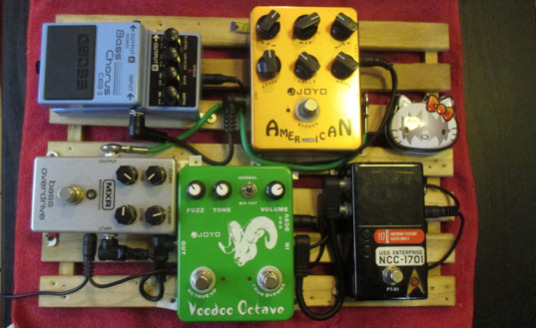
We all love pedals. But for the ‘gigging’ musician, setting them up can be a huge pain in the neck without some sort of board to keep them organized. There are plenty of options off-the-shelf, but most of them are either overpriced or overkill. Probably even worse, many of them require you to remove the rubber pads under your pedals in order to attach an often unreliable piece of Velcro. This devalues your pedals for resale and could likely fall apart during transport.
The pedal hack we’re laying out here could help prevent those issues from happening, helping you keep your pedals securely on your board while preserving their value on the secondhand market. This hack is suited for musicians who’ve already decided on their optimal signal chain layout based on both tone and convenience. But if you’re still constantly switching pedals around, this could be more inconvenient compared to the more popular velcro method.
Advantages:
Preserves the resale value of your pedals.
Rock solid compared to velcro. You can even flip the board upside-down if you want.
Much cheaper than any store-bought pedal board.
Much more customizable.
Disadvantages:
Not for the brand-conscious.
Not recommended for pedal newbies, who are still finding their ideal signal chain.
Things you will need:
Pedals
Any available pedal power system and cables
Bike chains (recommended) or shampoo bottles/reusable plastic food containers
Bike chain de-linker
Small wood screws
Screwdrivers
Scrap wood or any suitable board material.
Secondhand briefcase or messenger bag
Cleaning cloth (optional)
Step 1. Lay out your gear and your tools on a soft cloth.
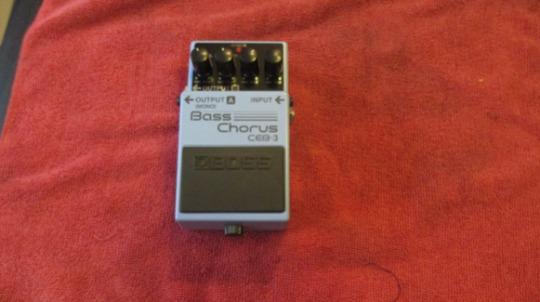
You don’t really have to do this, but doing so will prevent screws from rolling around and falling to the floor, only to be rediscovered by your bare feet when you get up in the middle of the night to pee. A soft cloth will also prevent the scuffs you’re trying to minimize on your pedal.
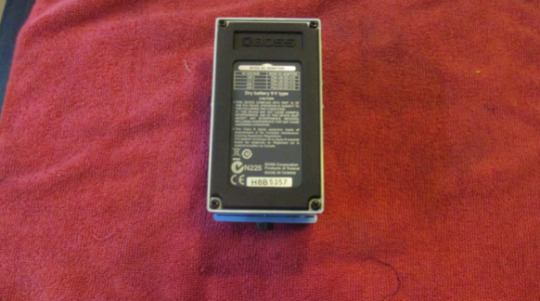
This is the rubber pad we’re trying to preserve. You could remove it and store it somewhere. But chances are you will lose it because that’s just the kind of person you are.

Here’s a short length of bike chain and a de-linking tool. Together they cost less than P250 (approx. $5) and will provide you with several pedal boards worth of bike links. Many of us already have broken bike chains and de-linking tools, but the lowest of losers have someone they can borrow or beg these from.
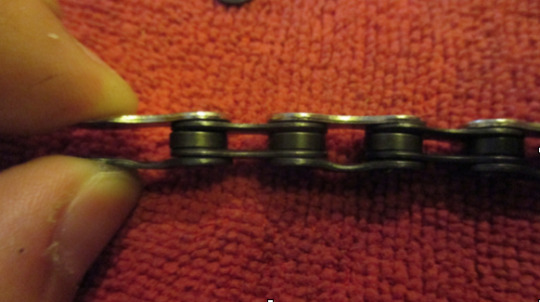
Notice there are 5 different parts in a typical bike chain. More on that later.

This de linker is a lifetime investment. This is for P150 (approx. $3)

The de-linker has a puncher and place to set your bike chain in.
Step 2: Set your chain in the de-linking tool
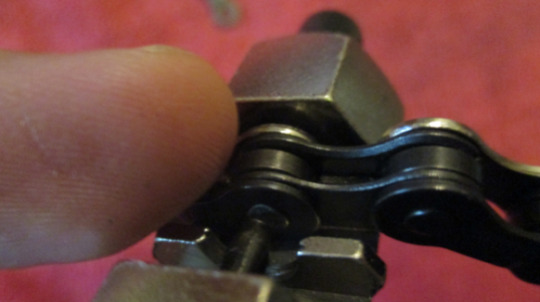
Place the bike chain into your de-linker like so. The pin (also called a rivet) has to be in the center.
Step 3: Remove the pins.
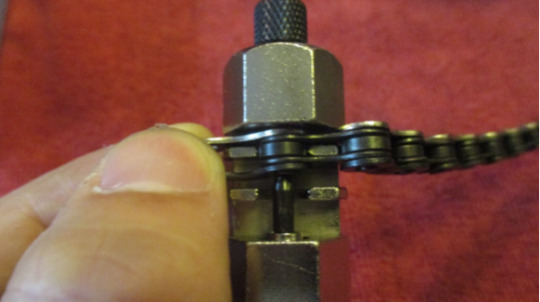
Align the chain pin with the puncher and twist the lever until the tool holds the chain securely.

Position the entire thing over the cloth (more on that later). As you twist the lever, the puncher moves forward, loosening the chain’s pin in the center. Punching the pin out requires a significant amount of force, but thanks to the leverage the tool provides, even a child can do it.

The pin will pop out of the hole at the end of your tool. Having the cloth underneath will catch the pin, so you’ll have less of a headache cleaning up later.
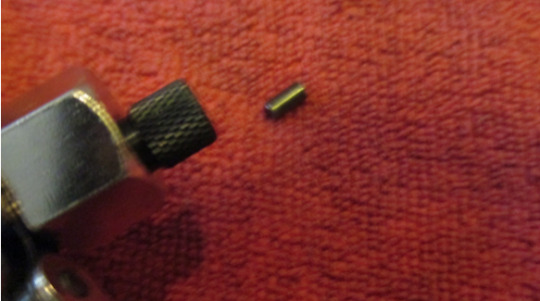
Here’s the extracted pin. Spin the tool lever in the opposite direction to release the chain links.
Step 4: Repeat above as needed
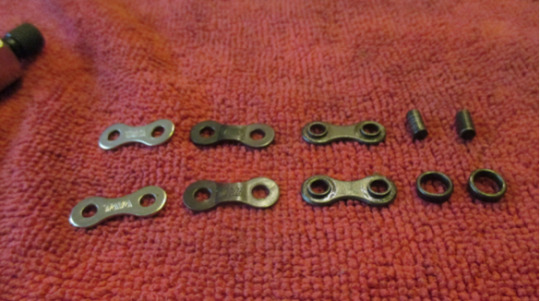
Repeat the above process another time with the inner part of the chain and you should get these parts. Notice that one of the inner links has a raised lip. Depending on your pedal’s design you might want to use or avoid this one. You can discard the pin and the rollers/spacers but keep all the spaces just in case. You could also use them as a DIY spacer for a bass string tree, if you would prefer.
Step 5: Check the pedal screw design.

Unfortunately, this DIY method will not work out “of the box” for Digitech, Hardwire, and TC Electronic pedals that use T5 or similar screws, unless you buy extra-long replacements with the proper heads and flanging. For 90% of other brands though, you should be in business. Take note that you can also do this process with pedal power supplies as well.
Step 6: Unscrew one corner on your pedal.
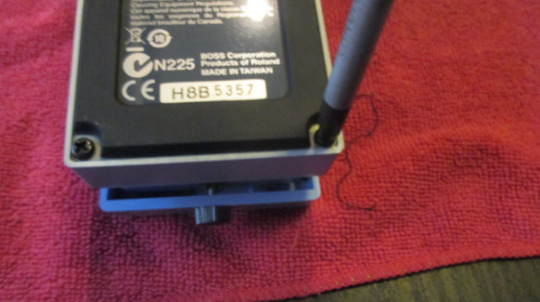
Use only the correct sized screwdrivers to prevent loose threads and keep screw heads from stripping out.
Step 7: Choose the right links!
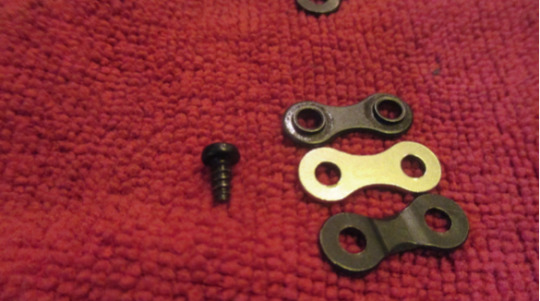
Now, we have to select the appropriate links to attach to the board. Notice the screw is a bit shallow, so we need to choose the link that allows the maximum amount of screw thread to remain in the pedal. If the screw hole is slightly recessed like with MXR and Joyo pedals, the link with the lip may be the best choice. With most pedals, this is not a big deal. But with Digitech, Hardwire, and TC Electronic pedals, the issue with them is that their stock screw heads are extremely recessed and are not as flat as standard. You can always buy replacement screws with a longer shaft and a flatter head, but these can be a pain to track down.
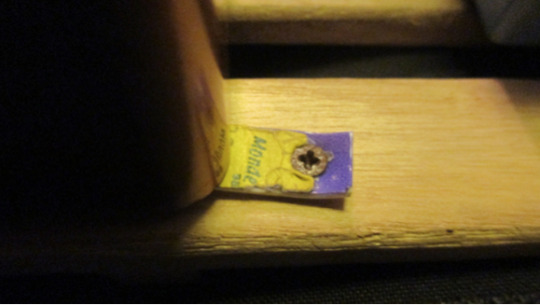
A workaround that still preserves value is to use zip ties, but those are annoying -- so whatever. You can also use plastic cut and shaped from shampoo bottles and similar containers – especially if your pedal or power brick screw holes are side-mounted rather than at the bottom. More on that later.
Step 8: Check thread depth.
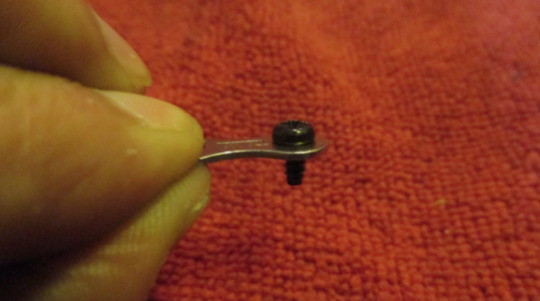
Perfect! More than enough threads to work with. On the off chance that the screw shaft is not long enough to grip onto your pedal properly, you may have to take the screw to a hardware store to find a version with a longer shaft, but the same diameter.
Step 9: Test bike chain link security

Secure the bike link to your pedal like so, but don’t over-tighten. Otherwise, you might strip the threads. If it feels secure, you should be fine.
Step 10: Repeat as many times as needed
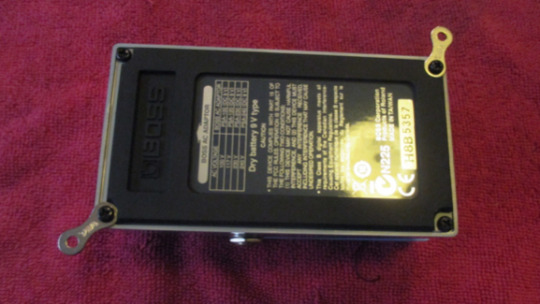
Most of the time, you only really need two chain links. We recommend putting more, but considering, this is a perfect fit on the Boss Bass Chorus, two shall be fine. With some Artec pedals, its recommended to add more as the threads didn’t seem to be quite deep enough, The screws were slightly flanged. In these cases, you can add plumber’s tape or a drop of nail polish to the screw threads to tighten them. For this example though, it’s not necessary.
Step 11: Pedal Tetris

Hopefully, you already know what order you want your pedals in. Otherwise, test different pedal and signal chain combinations before embarking on this project. This board is an P88 ($2) trivet for casseroles that we bought from a Saizen (a 100 yen store).
Pedals are more durable than most of us give them credit for. However, their power input pins and ¼” jacks can vulnerable to breakage if you apply leveraged force into them, which straight input plugs unfortunately provide loads off.
In the example board, we only have access to a daisy chain with straight plugs and a wall wart. Angled plugs will help keep the board compact, but in this case, we don’t have much of a choice. We have to work with what we’ve got. Notice in the example that the power plug juts out of the board area. We want to avoid this as much as possible to prevent straining the inputs.
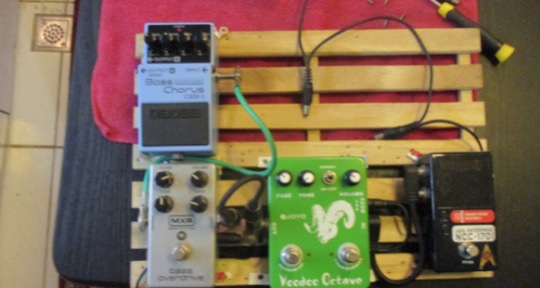
It’s best to loosen all the pedals from your board, if you’re attaching a new pedal to an already existing board. This will allow you to maximize your options. This is also an opportunity to fix spacing issues with your old layout.
Notice on the other pedals, we used the plastic cut from cracker boxes and shampoo bottles instead of bike links. This is almost as good, but looks less neat, and you really do need at least 3-4 tabs for security. Plastic tabs are also a viable option if your pedal or power brick screw holes are side-mounted rather than at the bottom.
The conventional layout is unacceptable as the power input will still be hanging outside the board. We want them inside the board as much as possible to minimize damage. Note that we used a pancake plug on the MXR Bass OD audio cable to prevent snagging. But this will be moot, later.
In any case, this is the time to choose and build/buy the correct length power and audio cables you plan to use with your board.

Here we decided that the Boss Bass Chorus’s signal outputs should facing “up”, relative to the board, rather than to the left as is conventional. This will prevent the power plugs from snagging in our pedal case and damaging the fragile power inputs.

If you have pedals with multiple inputs and outputs, be sure to position them so you have clearance to still use them with an angled plug. Here we are testing the clearance for auxiliary output on the tuner, which can be useful for bi-amping.
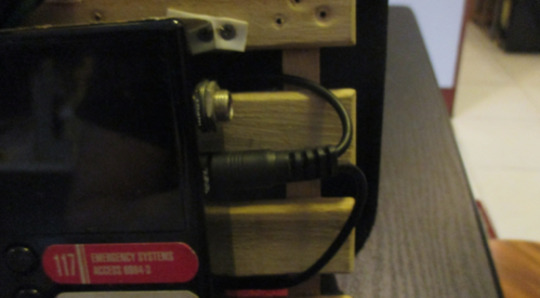
We also moved the tuner towards the center of the board as the power input used to snag a lot with the old set up, and necessitated removing after every use, which is kind of a pain.
Step 12. Time to screw!

When all your pedals (and pedal power supplies, if available) are aligned as needed and when all your cables have an acceptable amount of slack (so you can do basic maintenance easily), screw the bike links to the wood with a screwdriver you don’t mind getting abused.

Using screwdrivers this way can be harsh on the point bits, especially if they’re used to screw into harder types of wood. The board we’re using is made from pine, so it’s soft enough that our screwdriver won’t encounter much resistance. If your pedal board is made from harder woods, consider drilling first before attaching your screws.
Not pretty, but it works. This same pine board has been though hundreds of practice sessions and gigs in the past three years.
Step 13: Check your handiwork.
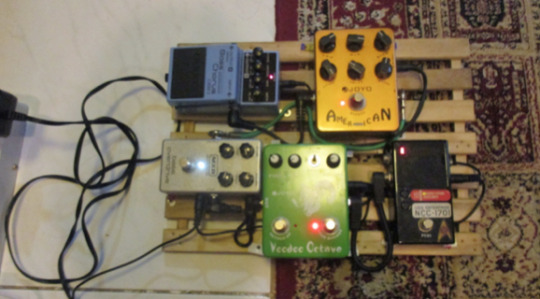
Plug in your power supply and test everything to make sure everything works properly. Be sure you are able to easily remove cables without needing to detach your pedals from the board.
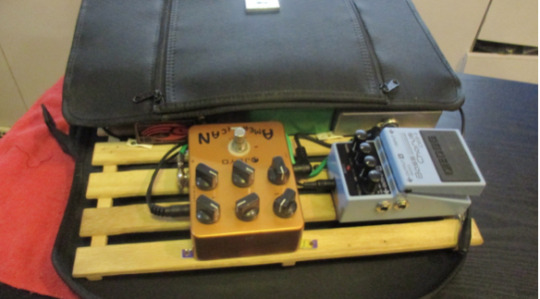
We found this bag in a secondhand shop (known locally as ukay-ukays or rilip). It’s a perfect fit for our pedal board. Cheap used laptop bags and briefcases abound, for around P200-P600 ($4-$12). Bring a measuring tape and be sure to account for total depth of the board with the pedals. It’s a bonus if the bag has a space for your cables and other essentials. We got this one for P200($4).
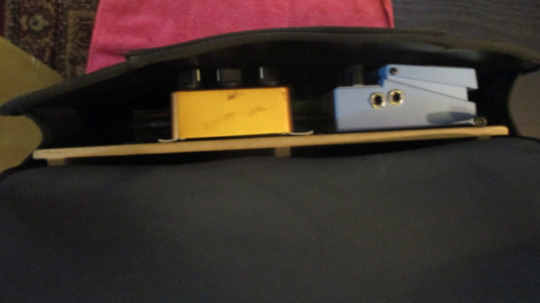
The front of the pedals are pretty darn durable, so even without padding, your gear should be fine and scuff free. But if the setup bothers you, you can stuff a piece of foam in there. Check your power and audio cables aren’t snagging on the edges of your enclosure.
Step 14: Rock and/or Roll

Voila, your DIY pedal board is ready! With this setup, you aren’t restricted to a specific placement like with the popular Boss and Behringer pedal boards.
Other things you can do with this DIY step:
If you know how to build your own power and audio cables, you can give them enough length (at the cost of signal capacitance, aka “tone suck”) so you can thread them under the slats for a neater appearance. Personally, tone suck is less of an issue than convenience and ergonomics in 99% of live settings.
If you are a singer who also plays guitar, you can split your board so you can get closer to the microphone. This would be the case if the venue does not provide boom stands. This way you can keep your gigging layout more ergonomic, as more than two pedals deep on single large boards can result in a pedal-dance cha-cha nightmare.
You can build a separate board for your amp’s preamp and another one for the effects loop.
You can easily build an all-modulation board so you can easily use your favorite modulation effects with instruments other than guitar – even with keyboards and mic preamps – without too the pain of constantly disconnecting your specialized guitar-centric pedals.
(Advanced protip: Your modulation effects will take a line-level signal)
Some may prefer an angled board. You may add a piece of scrap wood under the top part of your board to achieve this.
Have any questions about this pugpayo article? Drop us an ask in our ask box or send a message on our Facebook page.
0 notes